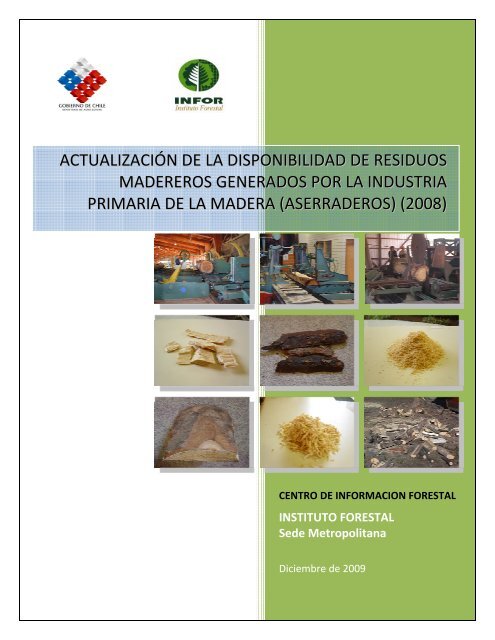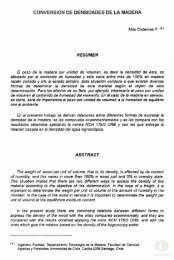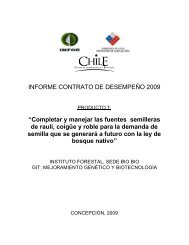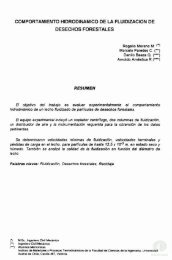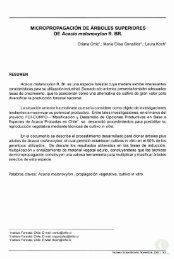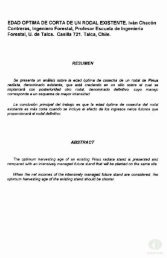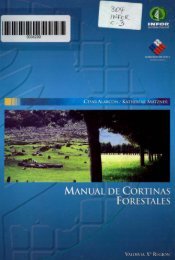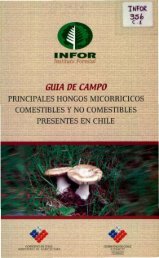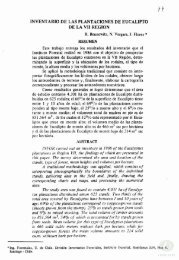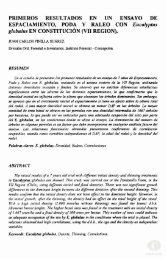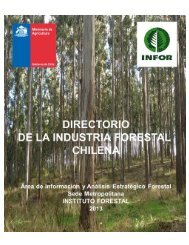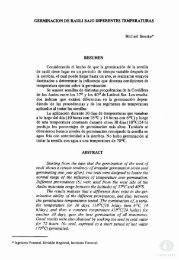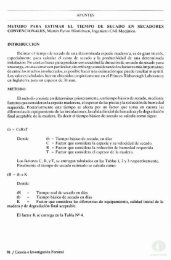actualización de la disponibilidad de residuos madereros ...
actualización de la disponibilidad de residuos madereros ...
actualización de la disponibilidad de residuos madereros ...
You also want an ePaper? Increase the reach of your titles
YUMPU automatically turns print PDFs into web optimized ePapers that Google loves.
ACTUALIZACIÓN DE LA DISPONIBILIDAD DE RESIDUOS<br />
MADEREROS GENERADOS POR LA INDUSTRIA<br />
PRIMARIA DE LA MADERA (ASERRADEROS) (2008)<br />
CENTRO DE INFORMACION FORESTAL<br />
INSTITUTO FORESTAL<br />
Se<strong>de</strong> Metropolitana<br />
Diciembre <strong>de</strong> 2009
Actualización <strong>disponibilidad</strong> <strong>de</strong> <strong>residuos</strong> ma<strong>de</strong>reros generados por <strong>la</strong> industria primaria <strong>de</strong> <strong>la</strong> ma<strong>de</strong>ra (2008)<br />
ACTUALIZACIÓN DE LA DISPONIBILIDAD DE RESIDUOS<br />
MADEREROS GENERADOS POR LA INDUSTRIA PRIMARIA<br />
DE LA MADERA (ASERRADEROS)<br />
(2008)<br />
Diciembre <strong>de</strong> 2009<br />
Centro <strong>de</strong> Información Forestal (CIF)<br />
INSTITUTO FORESTAL - Se<strong>de</strong> Metropolitana Página 2
Actualización <strong>disponibilidad</strong> <strong>de</strong> <strong>residuos</strong> ma<strong>de</strong>reros generados por <strong>la</strong> industria primaria <strong>de</strong> <strong>la</strong> ma<strong>de</strong>ra (2008)<br />
INDICE<br />
Introducción 3<br />
Objetivos 5<br />
Metodología 6<br />
Análisis <strong>de</strong> Resultados 8<br />
Resumen 26<br />
Centro <strong>de</strong> Información Forestal (CIF)<br />
INSTITUTO FORESTAL - Se<strong>de</strong> Metropolitana Página 3
Actualización <strong>disponibilidad</strong> <strong>de</strong> <strong>residuos</strong> ma<strong>de</strong>reros generados por <strong>la</strong> industria primaria <strong>de</strong> <strong>la</strong> ma<strong>de</strong>ra (2008)<br />
INTRODUCCIÓN<br />
Los estudios respecto <strong>de</strong>l Volumen y Disponibilidad <strong>de</strong> Residuos Ma<strong>de</strong>reros provenientes <strong>de</strong> <strong>la</strong><br />
Industria <strong>de</strong> <strong>la</strong> Ma<strong>de</strong>ra comienzan en el año 2006, cuando el Instituto Forestal (INFOR)<br />
<strong>de</strong>sarrol<strong>la</strong> <strong>la</strong> primera aplicación a nivel nacional (IV a XII Regiones). Este trabajo encomendado<br />
por <strong>la</strong> Comisión Nacional <strong>de</strong> Energía (CNE) y <strong>la</strong> Deutsche Gesellschaft für Technische<br />
Zusammenarbeit (GTZ) GmbH, se formu<strong>la</strong> en el contexto <strong>de</strong>l proyecto “Energías Renovables<br />
No Convencionales en Chile” implementado bajo el convenio <strong>de</strong> cooperación entre los<br />
gobiernos <strong>de</strong> Chile y Alemania.<br />
El estudio evalúa <strong>la</strong> situación al año 2005 sobre <strong>la</strong> <strong>disponibilidad</strong> <strong>de</strong> <strong>residuos</strong> ma<strong>de</strong>reros<br />
generados en los procesos <strong>de</strong> transformación primaria <strong>de</strong> <strong>la</strong> ma<strong>de</strong>ra (aserra<strong>de</strong>ros) que podrían<br />
ser aprovechados en <strong>la</strong> generación <strong>de</strong> energía, su origen (tipo <strong>de</strong> aserra<strong>de</strong>ro), el tipo <strong>de</strong><br />
residuo, volumen y <strong>de</strong>stino final. Estructuradas <strong>la</strong>s bases <strong>de</strong> datos e información, se <strong>de</strong>sarrol<strong>la</strong><br />
posteriormente una p<strong>la</strong>taforma <strong>de</strong> acceso usuario en <strong>la</strong> web, utilizando para ello un navegador<br />
cartográfico, que permite al interesado <strong>de</strong>splegar <strong>la</strong>s áreas o centros generadores <strong>de</strong> este tipo<br />
<strong>de</strong> <strong>residuos</strong> industriales, bajo diversas modalida<strong>de</strong>s <strong>de</strong> consulta (www.infor.cl/<strong>residuos</strong>). Los<br />
antece<strong>de</strong>ntes aportan valiosa información a los tomadores <strong>de</strong> <strong>de</strong>cisión, públicos y privados,<br />
sobre uno <strong>de</strong> los recursos <strong>de</strong> biomasa más importantes para el <strong>de</strong>sarrollo <strong>de</strong> <strong>la</strong>s energías<br />
renovables no convencionales (ERNC) en Chile, recursos que cada día y con mayor intensidad<br />
están siendo aprovechados para este propósito en empresas ligadas a <strong>la</strong> gran industria forestal.<br />
La problemática y <strong>la</strong>s variables <strong>de</strong>l entorno que justificaron este estudio, esto es, nuestra alta<br />
<strong>de</strong>pen<strong>de</strong>ncia <strong>de</strong> combustibles fósiles (petróleo y <strong>de</strong>rivados) en su mayoría importados, lo que se<br />
traduce en una mayor vulnerabilidad <strong>de</strong> nuestra matriz <strong>de</strong> consumo energético, y los problemas<br />
ambientales asociados con su empleo (calentamiento global atmosférico), continúan todavía<br />
plenamente vigentes. En el mundo, <strong>la</strong> necesidad imperiosa <strong>de</strong> buscar otras opciones<br />
energéticas alternativas ha volcado <strong>la</strong> mirada hacia <strong>la</strong> biomasa como una <strong>de</strong> <strong>la</strong>s fuentes con<br />
mayor potencial <strong>de</strong> <strong>de</strong>sarrollo, dada <strong>la</strong> diversidad <strong>de</strong> tecnologías <strong>de</strong> conversión existentes y ya<br />
probadas para producir una amplia variedad <strong>de</strong> productos, con <strong>de</strong>stino a diferentes mercados<br />
(transporte, químicos, generación, calefacción).<br />
En el año 2008 se realizan algunos estudios orientados a <strong>de</strong>terminar el potencial productivo <strong>de</strong><br />
<strong>la</strong> agricultura <strong>de</strong> nuestro país para <strong>la</strong> producción <strong>de</strong> biocombustibles líquidos (agroenergía), los<br />
que concluyen seña<strong>la</strong>ndo que Chile cuenta con escasas oportunida<strong>de</strong>s en este campo, razón<br />
por <strong>la</strong> cual los <strong>de</strong>sarrollos se reorientan a prospectar <strong>la</strong> posibilidad <strong>de</strong> producir biocombustibles<br />
a partir <strong>de</strong> material lignocelulósico (principalmente ma<strong>de</strong>ra). Esto, que sin duda añadirá nuevo<br />
valor a <strong>la</strong> producción forestal, también anticipa un futuro escenario <strong>de</strong> competencia en el<br />
mercado <strong>de</strong> <strong>la</strong> fibra (industria energética, pulpa, tableros), razón por <strong>la</strong> cual los trabajos<br />
<strong>de</strong>dicados a evaluar permanentemente <strong>la</strong>s fuentes generadoras <strong>de</strong> biomasa, resulta <strong>de</strong> gran<br />
importancia para calibrar <strong>la</strong>s oportunida<strong>de</strong>s y tomar <strong>la</strong>s <strong>de</strong>cisiones a<strong>de</strong>cuadas respecto <strong>de</strong><br />
montar capacida<strong>de</strong>s para el <strong>de</strong>sarrollo sustentable <strong>de</strong> una industria bioenergética en Chile.<br />
En virtud <strong>de</strong> ello, INFOR ha incorporado entre sus líneas <strong>de</strong> trabajo permanentes y con<br />
oportunidad <strong>de</strong>l <strong>de</strong>sarrollo <strong>de</strong> <strong>la</strong>s activida<strong>de</strong>s <strong>de</strong> catastro y muestreos en <strong>la</strong> industria primaria<br />
(aserra<strong>de</strong>ros), una sección especial <strong>de</strong>dicada a capturar datos sobre los <strong>residuos</strong> sólidos<br />
generados durante el proceso <strong>de</strong> transformación <strong>de</strong> <strong>la</strong>s trozas en ma<strong>de</strong>ra aserrada, que <strong>de</strong>finen<br />
el tipo, volumen y <strong>disponibilidad</strong> <strong>de</strong> los <strong>residuos</strong>, cómo están siendo gestionados (<strong>de</strong>stino) y los<br />
usuarios finales <strong>de</strong> esta biomasa. Los datos permitirán periódicamente ir actualizando los<br />
sistemas <strong>de</strong> consulta <strong>de</strong>sarrol<strong>la</strong>dos para bajar o <strong>de</strong>splegar este tipo <strong>de</strong> información.<br />
Centro <strong>de</strong> Información Forestal (CIF)<br />
INSTITUTO FORESTAL - Se<strong>de</strong> Metropolitana Página 4
Actualización <strong>disponibilidad</strong> <strong>de</strong> <strong>residuos</strong> ma<strong>de</strong>reros generados por <strong>la</strong> industria primaria <strong>de</strong> <strong>la</strong> ma<strong>de</strong>ra (2008)<br />
Este informe correspon<strong>de</strong> a <strong>la</strong> segunda actualización <strong>de</strong>l volumen y <strong>disponibilidad</strong> <strong>de</strong> <strong>residuos</strong><br />
ma<strong>de</strong>reros, luego <strong>de</strong>l estudio original <strong>de</strong>l año 2006, y es un producto comprometido por el<br />
Centro <strong>de</strong> Información Forestal (CIF) <strong>de</strong> <strong>la</strong> Se<strong>de</strong> Metropolitana <strong>de</strong>l Instituto Forestal, en el<br />
marco <strong>de</strong> <strong>la</strong>s activida<strong>de</strong>s respaldadas por el Ministerio <strong>de</strong> Agricultura, y en coherencia con uno<br />
<strong>de</strong> los ejes estratégicos <strong>de</strong> INFOR, cual es el <strong>de</strong> “satisfacer <strong>la</strong> <strong>de</strong>manda sectorial <strong>de</strong> información<br />
en los ámbitos económicos, social y ambiental”.<br />
Centro <strong>de</strong> Información Forestal (CIF)<br />
INSTITUTO FORESTAL - Se<strong>de</strong> Metropolitana Página 5
Actualización <strong>disponibilidad</strong> <strong>de</strong> <strong>residuos</strong> ma<strong>de</strong>reros generados por <strong>la</strong> industria primaria <strong>de</strong> <strong>la</strong> ma<strong>de</strong>ra (2008)<br />
OBJETIVOS<br />
Los objetivos que a continuación se enuncian son los <strong>de</strong>finidos para esta línea <strong>de</strong> trabajo<br />
permanente a cargo <strong>de</strong>l Centro <strong>de</strong> Información Forestal, en el que se inscriben tanto los<br />
catastros industriales (industria primaria y secundaria <strong>de</strong> <strong>la</strong> ma<strong>de</strong>ra) como los que, en particu<strong>la</strong>r,<br />
guardan re<strong>la</strong>ción con el levantamiento <strong>de</strong> información sobre <strong>residuos</strong> ma<strong>de</strong>reros generados por<br />
<strong>la</strong> industria <strong>de</strong> <strong>la</strong> ma<strong>de</strong>ra.<br />
El objetivo general es actualizar periódicamente <strong>la</strong> información <strong>de</strong> <strong>disponibilidad</strong> <strong>de</strong> <strong>residuos</strong><br />
ma<strong>de</strong>reros generados en <strong>la</strong> industria primaria <strong>de</strong> <strong>la</strong> ma<strong>de</strong>ra (aserra<strong>de</strong>ros) a nivel nacional.<br />
Los objetivos específicos son:<br />
1. Realizar periódicamente y en sincronía con los catastros <strong>de</strong> <strong>la</strong> industria primaria, <strong>la</strong><br />
captura <strong>de</strong> datos re<strong>la</strong>tivos a los <strong>residuos</strong> ma<strong>de</strong>reros generados en el proceso <strong>de</strong><br />
transformación <strong>de</strong> <strong>la</strong> ma<strong>de</strong>ra (trozas) en ma<strong>de</strong>ra aserrada.<br />
2. Determinar el tipo, volumen y <strong>de</strong>stino <strong>de</strong> estos <strong>residuos</strong>.<br />
3. Actualizar los sistemas <strong>de</strong> consulta <strong>de</strong>sarrol<strong>la</strong>dos para bajar o <strong>de</strong>splegar información<br />
gráfica o numérica (navegador cartográfico).<br />
4. Perfeccionar o fortalecer los sistemas administradores <strong>de</strong> <strong>la</strong> información, con nuevos<br />
algoritmos <strong>de</strong> procesamiento y generación <strong>de</strong> reportes o informes para enriquecer los<br />
análisis.<br />
Centro <strong>de</strong> Información Forestal (CIF)<br />
INSTITUTO FORESTAL - Se<strong>de</strong> Metropolitana Página 6
Actualización <strong>disponibilidad</strong> <strong>de</strong> <strong>residuos</strong> ma<strong>de</strong>reros generados por <strong>la</strong> industria primaria <strong>de</strong> <strong>la</strong> ma<strong>de</strong>ra (2008)<br />
METODOLOGÍA<br />
La metodología empleada está <strong>de</strong>finida en el marco <strong>de</strong>l estudio base original realizado en el<br />
año 2006, y pue<strong>de</strong> ser consultada en el documento Disponibilidad <strong>de</strong> Residuos Ma<strong>de</strong>reros <strong>de</strong> <strong>la</strong><br />
Industria Primaria <strong>de</strong> <strong>la</strong> Ma<strong>de</strong>ra para su Uso Energético, publicado conjuntamente por <strong>la</strong><br />
Comisión Nacional <strong>de</strong> Energía (CNE), el Instituto Forestal (INFOR) y el organismo <strong>de</strong><br />
cooperación técnica alemana Deutsche Gesellschaft für Technische Zusammenarbeit (GTZ)<br />
GmbH, en el año 2007.<br />
En líneas generales esta metodología, <strong>de</strong>finida en el contexto <strong>de</strong>l Catastro <strong>de</strong> <strong>la</strong> Industria<br />
Primaria <strong>de</strong> <strong>la</strong> Ma<strong>de</strong>ra (aserra<strong>de</strong>ros), como se ha seña<strong>la</strong>do anteriormente, una actividad<br />
permanente <strong>de</strong>l Centro <strong>de</strong> Información Forestal <strong>de</strong> INFOR (CIF), compren<strong>de</strong> los siguientes<br />
pasos:<br />
• Define los términos asociados a <strong>la</strong> industria <strong>de</strong>l aserrío y al tipo <strong>de</strong> <strong>residuos</strong> que el<strong>la</strong><br />
genera;<br />
• Establece <strong>la</strong>s bases conceptuales y variables para compren<strong>de</strong>r el flujo o proceso <strong>de</strong><br />
transformación <strong>de</strong> <strong>la</strong> ma<strong>de</strong>ra, <strong>de</strong>l que se <strong>de</strong>riva un importante volumen <strong>de</strong> biomasa<br />
residual;<br />
• Determina los factores <strong>de</strong> rendimiento y <strong>la</strong> proporción <strong>de</strong> <strong>residuos</strong> que genera cada tipo<br />
<strong>de</strong> aserra<strong>de</strong>ro en función <strong>de</strong>l tipo <strong>de</strong> maquinarias;<br />
• Configura los procedimientos a través <strong>de</strong>l cual se capturan, registran y procesan los<br />
datos <strong>de</strong> los aserra<strong>de</strong>ros: incluye e<strong>la</strong>boración <strong>de</strong> encuestas para <strong>la</strong> realización <strong>de</strong> los<br />
catastros <strong>de</strong> industrias, constituyan éstos censos o muestreos y <strong>la</strong> aplicación <strong>de</strong> <strong>la</strong>s<br />
mismas;<br />
• Ingreso y procesamiento <strong>de</strong> los datos al interior <strong>de</strong> un sistema <strong>de</strong> información diseñado<br />
para tales efectos, el que es mantenido y administrado con <strong>la</strong> finalidad que los usuarios<br />
<strong>de</strong>l CIF obtengan reportes o informes <strong>de</strong> acuerdo a <strong>de</strong>terminados agrupamiento <strong>de</strong><br />
datos (exportación <strong>de</strong> datos).<br />
En esta oportunidad, <strong>la</strong> base <strong>de</strong> datos utilizada para <strong>de</strong>terminar el volumen <strong>de</strong> <strong>residuos</strong><br />
ma<strong>de</strong>reros, correspon<strong>de</strong> a <strong>la</strong> <strong>de</strong>l Catastro <strong>de</strong> <strong>la</strong> Industria Primaria 2008, cuya recolección <strong>de</strong><br />
datos se ejecutó en el período estival 2009. Estos datos registran <strong>la</strong> situación <strong>de</strong> los<br />
aserra<strong>de</strong>ros al año 2008, que hayan estado o no trabajando en ese año.<br />
Los datos básicos a partir <strong>de</strong>l cual se obtiene el volumen <strong>de</strong> <strong>residuos</strong> ma<strong>de</strong>reros son el<br />
consumo (m 3 ssc) y <strong>la</strong> producción (m 3 ssc). Conviene precisar en este punto que todos los<br />
aserra<strong>de</strong>ros informan <strong>la</strong> producción anual, más no todos el consumo anual. Normalmente <strong>la</strong><br />
mayoría <strong>de</strong> los aserra<strong>de</strong>ros pequeños y otra parte importante <strong>de</strong> los medianos, no proporcionan<br />
los datos <strong>de</strong> consumo anual, por lo que se proce<strong>de</strong> en este caso a calcu<strong>la</strong>rles esta variable.<br />
Esto se practica aplicando los factores <strong>de</strong> rendimiento tabu<strong>la</strong>dos para cada tipo <strong>de</strong> aserra<strong>de</strong>ro,<br />
cuyo tipo <strong>de</strong> maquinaria o sierra principal <strong>de</strong>termina el volumen <strong>de</strong> salida <strong>de</strong> ma<strong>de</strong>ra aserrada, y<br />
por en<strong>de</strong> también el volumen <strong>de</strong> <strong>residuos</strong> ma<strong>de</strong>reros.<br />
Con el dato <strong>de</strong> consumo calcu<strong>la</strong>do o informado por los aserra<strong>de</strong>ros se <strong>de</strong>duce mediante los<br />
factores <strong>de</strong> <strong>de</strong>scuento tabu<strong>la</strong>dos para cada tipo <strong>de</strong> aserra<strong>de</strong>ro, <strong>la</strong> biomasa residual consistente<br />
Centro <strong>de</strong> Información Forestal (CIF)<br />
INSTITUTO FORESTAL - Se<strong>de</strong> Metropolitana Página 7
Actualización <strong>disponibilidad</strong> <strong>de</strong> <strong>residuos</strong> ma<strong>de</strong>reros generados por <strong>la</strong> industria primaria <strong>de</strong> <strong>la</strong> ma<strong>de</strong>ra (2008)<br />
en <strong>la</strong>mpazos, aserrín y corteza. En este último caso, para obtener el volumen <strong>de</strong> corteza, se<br />
aplican los factores <strong>de</strong> <strong>de</strong>scuento en función <strong>de</strong>l tamaño o diámetro <strong>de</strong> <strong>la</strong>s trozas con que se<br />
abastece normalmente el aserra<strong>de</strong>ro (éstos informan <strong>la</strong> distribución re<strong>la</strong>tiva <strong>de</strong> <strong>la</strong>s trozas,<br />
c<strong>la</strong>sificadas por rango diamétrico).<br />
En el caso <strong>de</strong> los aserra<strong>de</strong>ros que cuentan con máquinas astil<strong>la</strong>doras, el volumen <strong>de</strong><br />
producción <strong>de</strong> astil<strong>la</strong>s (consi<strong>de</strong>rado como subproducto sólo en el caso que no contenga<br />
corteza), se asume equivalente al volumen <strong>de</strong> <strong>la</strong>mpazos, principal insumo para <strong>la</strong>s unida<strong>de</strong>s<br />
chipeadoras con que cuentan muchos aserra<strong>de</strong>ros; otro insumo lo representan los <strong>de</strong>spuntes<br />
generados en aserra<strong>de</strong>ros que presentan líneas <strong>de</strong> e<strong>la</strong>boración y remanufacturas.<br />
En consi<strong>de</strong>ración a esto último, esto es, dado que existen aserra<strong>de</strong>ros con líneas <strong>de</strong><br />
e<strong>la</strong>boración y remanufacturas en <strong>la</strong>s mismas insta<strong>la</strong>ciones, este trabajo <strong>de</strong> actualización<br />
cuantifica también <strong>la</strong> generación <strong>de</strong> <strong>residuos</strong> secundarios (<strong>de</strong>spuntes, viruta y aserrín). Para tal<br />
efecto, y al igual que para los <strong>residuos</strong> primarios, se aplican factores <strong>de</strong> <strong>de</strong>scuento según tipo<br />
<strong>de</strong> aserra<strong>de</strong>ro a <strong>la</strong> proporción <strong>de</strong> ma<strong>de</strong>ra aserrada que se somete a reproceso, normalmente el<br />
100%, particu<strong>la</strong>rmente en aserra<strong>de</strong>ros gran<strong>de</strong>s más dotados en maquinarias.<br />
Finalmente, se pasa revista a <strong>la</strong> distribución <strong>de</strong>l volumen <strong>de</strong> <strong>residuos</strong> ma<strong>de</strong>reros según su<br />
<strong>de</strong>stino, <strong>de</strong>s<strong>de</strong> el punto <strong>de</strong> vista <strong>de</strong> su gestión, esto es, cuántos <strong>de</strong> éstos son comercializados,<br />
autoconsumidos en <strong>la</strong> propia industria, rega<strong>la</strong>dos o acumu<strong>la</strong>dos en los patios <strong>de</strong> los<br />
aserra<strong>de</strong>ros.<br />
Centro <strong>de</strong> Información Forestal (CIF)<br />
INSTITUTO FORESTAL - Se<strong>de</strong> Metropolitana Página 8
Actualización <strong>disponibilidad</strong> <strong>de</strong> <strong>residuos</strong> ma<strong>de</strong>reros generados por <strong>la</strong> industria primaria <strong>de</strong> <strong>la</strong> ma<strong>de</strong>ra (2008)<br />
ANÁLISIS DE RESULTADOS<br />
Número y tipo <strong>de</strong> aserra<strong>de</strong>ros<br />
La base pob<strong>la</strong>cional o universo <strong>de</strong> aserra<strong>de</strong>ros para el año 2008 comprendió un número <strong>de</strong><br />
1.310 unida<strong>de</strong>s productivas, localizadas entre <strong>la</strong> Región <strong>de</strong> Valparaíso y <strong>la</strong> Región <strong>de</strong><br />
Magal<strong>la</strong>nes. De el<strong>la</strong>s, 173 industrias (13,2%) se encontraron paralizadas durante ese año, y por<br />
lo tanto no registraron producción, lo que <strong>de</strong>ja un total <strong>de</strong> 1.137 establecimientos activos.<br />
El número <strong>de</strong> aserra<strong>de</strong>ros por tipo y Región se presentan en el siguiente cuadro.<br />
Cuadro Nº 1<br />
Número <strong>de</strong> Aserra<strong>de</strong>ros activos presentes en <strong>la</strong> zona <strong>de</strong> estudio, según tipo y Región (2008)<br />
Región<br />
Permanente Permanente<br />
c/e<strong>la</strong>boración c/remanufactura<br />
Permanente<br />
tradicional<br />
Total<br />
Tipo <strong>de</strong> Aserra<strong>de</strong>ro<br />
Móvil Portátil Móvil Portátil<br />
c/e<strong>la</strong>boración tradicional<br />
Total<br />
Móvil<br />
Tradicional<br />
c/e<strong>la</strong>boración<br />
Móvil<br />
Tradicional<br />
Valparaiso 7 9 16 1 1 17 1,5<br />
Metropolitana 1 1 3 3 4 0,4<br />
O'Higgins 14 4 18 10 10 9 21 30 58 5,1<br />
Maule 34 1 45 80 1 1 2 4 42 46 128 11,3<br />
Bío Bío 51 14 47 112 1 45 46 13 80 93 251 22,1<br />
Araucanía 24 4 23 51 16 224 240 9 23 32 323 28,4<br />
Los Ríos 30 3 10 43 13 56 69 3 9 12 124 10,9<br />
Los Lagos 25 1 11 37 11 65 76 7 51 58 171 15,0<br />
Aysén 1 8 9 3 27 30 1 5 6 45 4,0<br />
Magal<strong>la</strong>nes 4 10 14 1 1 1 1 16 1,4<br />
TOTAL 190 23 167 380 45 430 475 47 235 282 1137 100,0<br />
% 16,7 2,0 14,7 33,4 4,0 37,8 41,8 4,1 20,7 24,8 100,0<br />
Fuente: Base <strong>de</strong> datos INFOR, 2008.<br />
Total<br />
TOTAL %<br />
La componente más importante son los aserra<strong>de</strong>ros móviles (757 unida<strong>de</strong>s: 475 <strong>de</strong> ellos son<br />
móviles <strong>de</strong> tipo portátil y 351 móviles <strong>de</strong>l tipo tradicional), los cuales representan el 65,1% <strong>de</strong>l<br />
total <strong>de</strong> aserra<strong>de</strong>ros existentes en <strong>la</strong> zona <strong>de</strong> estudio. Este tipo <strong>de</strong> aserra<strong>de</strong>ros sufrieron una<br />
merma <strong>de</strong> 96 unida<strong>de</strong>s respecto <strong>de</strong>l año 2007, <strong>de</strong>bido a falta <strong>de</strong> abastecimiento y baja en <strong>la</strong><br />
<strong>de</strong>manda interna <strong>de</strong> ma<strong>de</strong>ras. En tanto que los aserra<strong>de</strong>ros permanentes suman 380 unida<strong>de</strong>s<br />
representando el 33,4% <strong>de</strong>l total <strong>de</strong> aserra<strong>de</strong>ros, un número importante <strong>de</strong> ellos cuentan con<br />
línea <strong>de</strong> e<strong>la</strong>boración o <strong>de</strong> remanufactura. En este segmento también se registra una baja <strong>de</strong> 77<br />
unida<strong>de</strong>s, <strong>de</strong>bido a los efectos <strong>de</strong> <strong>la</strong> crisis financiera internacional que ya comienza a<br />
manifestarse en nuestro país en el año 2008.<br />
En cuanto a localización, <strong>la</strong> distribución por región muestra que el 87,7% <strong>de</strong> los aserra<strong>de</strong>ros<br />
activos se concentran entre <strong>la</strong> Región <strong>de</strong>l Maule (VII) y <strong>la</strong> Región <strong>de</strong> Los Lagos (X), en total 997<br />
unida<strong>de</strong>s, 13% menos que los registrados en el año 2007.<br />
Con respecto a su situación al año 2008, el Cuadro Nº 2 muestra que <strong>la</strong> mayor parte <strong>de</strong> los<br />
aserra<strong>de</strong>ros paralizados se encuentran localizados también entre <strong>la</strong>s Regiones <strong>de</strong>l Maule y Los<br />
Lagos, 124 aserra<strong>de</strong>ros <strong>de</strong> un total <strong>de</strong> 148, afectando mayormente al segmento <strong>de</strong> aserra<strong>de</strong>ros<br />
móviles (70%), principalmente los tradicionales <strong>de</strong> <strong>la</strong>s regiones <strong>de</strong>l Maule, Biobío y Los Lagos.<br />
Centro <strong>de</strong> Información Forestal (CIF)<br />
INSTITUTO FORESTAL - Se<strong>de</strong> Metropolitana Página 9
Actualización <strong>disponibilidad</strong> <strong>de</strong> <strong>residuos</strong> ma<strong>de</strong>reros generados por <strong>la</strong> industria primaria <strong>de</strong> <strong>la</strong> ma<strong>de</strong>ra (2008)<br />
Cuadro Nº 2<br />
Número <strong>de</strong> aserra<strong>de</strong>ros por región, según tipo y situación <strong>de</strong> trabajo (2008)<br />
Tipo aserra<strong>de</strong>ro y<br />
situación Valparaiso Metrop. O'Higgins Maule Bío Bío Araucanía Los Ríos Los Lagos Aysén Magal<strong>la</strong>nes Total<br />
Permanente 16 18 89 125 57 46 43 10 21 425<br />
paralizados 9 13 6 3 6 1 7 45<br />
trabajando 16 18 80 112 51 43 37 9 14 380<br />
Móvil Portátil 1 10 2 51 268 75 81 37 2 527<br />
nuevos 3 12 2 2 19<br />
paralizados 2 16 4 3 7 1 33<br />
trabajando 1 10 2 46 240 69 76 30 1 475<br />
Móvil Tradicional 2 3 36 58 118 41 15 75 7 2 357<br />
nuevos 1 4 5<br />
paralizados 1 5 12 21 9 3 17 1 1 70<br />
trabajando 1 3 30 46 93 32 12 58 6 1 282<br />
Totales 18 4 64 149 294 366 136 199 54 25 1309<br />
nuevos 0 0 1 0 7 12 2 2 0 0 24<br />
paralizados 1 0 5 21 36 31 10 26 9 9 148<br />
trabajando 17 4 58 128 251 323 124 171 45 16 1137<br />
El cuadro anterior es organizado esta vez para mostrar el número <strong>de</strong> aserra<strong>de</strong>ros por rango <strong>de</strong><br />
producción que se encontraban trabajando el año 2008 (Cuadro Nº 3).<br />
Cuadro Nº 3<br />
Número <strong>de</strong> aserra<strong>de</strong>ros por región,<br />
según tipo y rango <strong>de</strong> producción (m 3 /año) (2008)<br />
Tipo Aserra<strong>de</strong>ro y<br />
REGION<br />
Rango <strong>de</strong> Producción Valparaíso RM O'Higgins Maule Biobio Araucanía Los Ríos Los Lagos Aysén Magal<strong>la</strong>nes<br />
Total<br />
Permanentes 16 18 80 112 51 43 37 9 14 380<br />
>300.000 5 1 6<br />
200.001‐300.000 1 4 5<br />
100.001‐200.000 2 3 2 7<br />
50.001‐100.000 3 4 2 9<br />
20.001‐50.000 2 6 11 2 2 1 24<br />
10.001‐20.000 8 16 3 2 1 30<br />
5.000‐10.000 1 5 24 14 11 3 3 61<br />
5.000 3 3<br />
3.001‐5.000 7 3 1 11<br />
1.000‐3.000 10 12 9 5 36<br />
5.000 1 1 2<br />
3.001‐5.000 1 1 1 3<br />
1.000‐3.000 5 1 8 3 6 2 25<br />
Actualización <strong>disponibilidad</strong> <strong>de</strong> <strong>residuos</strong> ma<strong>de</strong>reros generados por <strong>la</strong> industria primaria <strong>de</strong> <strong>la</strong> ma<strong>de</strong>ra (2008)<br />
Producción <strong>de</strong> ma<strong>de</strong>ra aserrada<br />
Según los datos informados por <strong>la</strong>s empresas, <strong>la</strong> producción total <strong>de</strong> ma<strong>de</strong>ra aserrada ascien<strong>de</strong><br />
a 7.306.046 m 3 ssc, que organizada por rango reve<strong>la</strong> que los aserra<strong>de</strong>ros “gran<strong>de</strong>s” con<br />
producciones superiores a 45.000 m 3 ssc/año, en total sólo 30 industrias (2,6%), representan<br />
más <strong>de</strong>l 70% <strong>de</strong> <strong>la</strong> producción nacional <strong>de</strong> ma<strong>de</strong>ra aserrada (Cuadro Nº 4), manteniendo sin<br />
gran<strong>de</strong>s variaciones <strong>la</strong> ten<strong>de</strong>ncia <strong>de</strong> años anteriores. En oposición, el 70,9% <strong>de</strong> los aserra<strong>de</strong>ros<br />
sólo representan el 2,8% <strong>de</strong> <strong>la</strong> producción nacional.<br />
Rango <strong>de</strong> producción<br />
(m3 ssc/año)<br />
Cuadro Nº 4<br />
Número <strong>de</strong> Industrias y producción total <strong>de</strong> ma<strong>de</strong>ra aserrada,<br />
según nivel o rango <strong>de</strong> producción (2008)<br />
Nº <strong>de</strong><br />
aserra<strong>de</strong>ros<br />
%<br />
Producción acum.<br />
(m3 ssc/año)<br />
Producción<br />
(%)<br />
45.000 + 30 2,6 5.150.588 70,5<br />
10.000 ‐ 45.000 52 4,6 1.012.193 13,9<br />
1.000 ‐ 10.000 249 21,9 935.535 12,8<br />
0 ‐ 1.000 806 70,9 207.730 2,8<br />
Total 1137 100,0 7.306.046 100,0<br />
El Cuadro Nº 5 muestra <strong>la</strong> distribución regional <strong>de</strong> <strong>la</strong> producción <strong>de</strong> ma<strong>de</strong>ra aserrada, según el<br />
tipo <strong>de</strong> aserra<strong>de</strong>ro. Con respecto al año 2007, no se observan diferencias significativas en <strong>la</strong><br />
producción <strong>de</strong> ma<strong>de</strong>ra e<strong>la</strong>borada por parte <strong>de</strong> los aserra<strong>de</strong>ros móviles, pero sí en los<br />
aserra<strong>de</strong>ros permanentes (gran<strong>de</strong>s empresas), que registran un aumento <strong>de</strong> más <strong>de</strong>l 70% en el<br />
rubro ma<strong>de</strong>ra e<strong>la</strong>borada y 16% en remanufacturas.<br />
Cuadro Nº 5<br />
Producción <strong>de</strong> ma<strong>de</strong>ra aserrada (m 3 ssc) en <strong>la</strong> zona <strong>de</strong> estudio,<br />
por tipo <strong>de</strong> aserra<strong>de</strong>ro (2008)<br />
REGION<br />
Permanente Móvil portátil Móvil tradicional<br />
Total Total<br />
c/e<strong>la</strong>b. c/reman. tradicional c/e<strong>la</strong>b. tradicional c/e<strong>la</strong>b. tradicional<br />
Total TOTAL %<br />
Valparaíso 9.986 11.247 21.233 0 309 309 21.542 0,3<br />
Metropolitana 0 309 309 482 482 792 0,0<br />
O'Higgins 80.859 43.985 124.845 22.269 22.269 11.423 13.956 25.379 172.493 2,4<br />
Maule 512.767 24.000 735.801 1.272.568 825 5.700 6.525 10.304 63.051 73.355 1.352.447 18,5<br />
Biobio 484.627 743.689 3.078.645 4.306.961 742 18.320 19.062 3.592 41.002 44.593 4.370.616 59,8<br />
Araucanía 169.368 102.204 312.808 584.380 6.394 52.788 59.183 5.241 13.171 18.412 661.975 9,1<br />
Los Ríos 421.632 77.417 16.370 515.419 6.312 22.568 28.879 899 1.836 2.736 547.034 7,5<br />
Los Lagos 67.198 3.029 10.515 80.742 10.241 20.936 31.176 2.976 9.230 12.206 124.124 1,7<br />
Aysén 1.348 2.125 3.473 224 5.788 6.012 94 927 1.021 10.506 0,1<br />
Magal<strong>la</strong>nes 19.457 23.998 43.454 708 708 354 354 44.516 0,6<br />
TOTAL 1.767.241 950.339 4.235.494 6.953.075 24.738 149.385 174.123 34.838 144.010 178.848 7.306.046 100,0<br />
Como pue<strong>de</strong> observarse <strong>la</strong> Región <strong>de</strong>l Biobío continúa sin variaciones respecto <strong>de</strong>l año 2007,<br />
concentrando <strong>la</strong> producción nacional <strong>de</strong> ma<strong>de</strong>ra aserrada con casi el 60%, seguida muy<br />
distante por <strong>la</strong> Región <strong>de</strong>l Maule (18,5%).<br />
En cuanto al tipo <strong>de</strong> aserra<strong>de</strong>ro, al igual que en el año 2007, <strong>de</strong>l total <strong>de</strong> ma<strong>de</strong>ra aserrada<br />
producida, más <strong>de</strong>l 95% se produce en aserra<strong>de</strong>ros permanentes, mayoritariamente en<br />
Centro <strong>de</strong> Información Forestal (CIF)<br />
INSTITUTO FORESTAL - Se<strong>de</strong> Metropolitana Página 11
Actualización <strong>disponibilidad</strong> <strong>de</strong> <strong>residuos</strong> ma<strong>de</strong>reros generados por <strong>la</strong> industria primaria <strong>de</strong> <strong>la</strong> ma<strong>de</strong>ra (2008)<br />
aserra<strong>de</strong>ros permanentes tradicionales (58%), lo que representa un aumento <strong>de</strong> más <strong>de</strong>l 4%<br />
respecto <strong>de</strong>l mismo año (Gráfico Nº 1). La <strong>de</strong>clinación ostensible en <strong>la</strong> producción <strong>de</strong> ma<strong>de</strong>ra<br />
e<strong>la</strong>borada y remanufacturas observada en el año 2007 respecto <strong>de</strong> 2005, se constata<br />
nuevamente en el año 2008, con reducciones <strong>de</strong>l or<strong>de</strong>n <strong>de</strong>l 11% y 34%, respectivamente,<br />
respecto <strong>de</strong>l año 2007, con lo que queda nuevamente <strong>de</strong>mostrado los ajustes operados en esta<br />
industria en el contexto <strong>de</strong> <strong>la</strong> recesión económica mundial.<br />
Gráfico Nº 1<br />
Distribución <strong>de</strong> <strong>la</strong> producción <strong>de</strong> ma<strong>de</strong>ra aserrada (m 3 ssc),<br />
por tipo <strong>de</strong> aserra<strong>de</strong>ro (2008)<br />
0,3% 2,0% 0,5% 2,0%<br />
58,0%<br />
24,2%<br />
13,0%<br />
Permanente c/e<strong>la</strong>boración<br />
Permanente c/remanufactura<br />
Permanente tradicional<br />
Móvil portátil c/e<strong>la</strong>boración<br />
Móvil portátil tradicional<br />
Móvil tradicional c/e<strong>la</strong>boración<br />
Móvil tradicional s/e<strong>la</strong>boración<br />
Como se señaló anteriormente, una proporción significativa <strong>de</strong>l volumen <strong>de</strong> ma<strong>de</strong>ra aserrada<br />
(58%) es producido en aserra<strong>de</strong>ros permanentes <strong>de</strong> tipo tradicional y comercializado en tal<br />
condición, principalmente en el mercado interno (industria e<strong>la</strong>boradora <strong>de</strong> ma<strong>de</strong>ras o barracas,<br />
etc.). Por otra parte, tratándose <strong>de</strong> los aserra<strong>de</strong>ros móviles, éstos en su mayor parte tienen por<br />
objetivo <strong>la</strong> producción <strong>de</strong> ma<strong>de</strong>ra en bruto. Sólo en contados casos estos aserra<strong>de</strong>ros se han<br />
insta<strong>la</strong>do <strong>de</strong> manera más permanente para e<strong>la</strong>borar ma<strong>de</strong>ras.<br />
La distribución regional <strong>de</strong> <strong>la</strong> producción <strong>de</strong> ma<strong>de</strong>ra aserrada, por tipo <strong>de</strong> aserra<strong>de</strong>ro y rango <strong>de</strong><br />
producción se muestra en el siguiente Cuadro Nº 6.<br />
Centro <strong>de</strong> Información Forestal (CIF)<br />
INSTITUTO FORESTAL - Se<strong>de</strong> Metropolitana Página 12
Actualización <strong>disponibilidad</strong> <strong>de</strong> <strong>residuos</strong> ma<strong>de</strong>reros generados por <strong>la</strong> industria primaria <strong>de</strong> <strong>la</strong> ma<strong>de</strong>ra (2008)<br />
Cuadro Nº 6<br />
Producción <strong>de</strong> ma<strong>de</strong>ra aserrada (m 3 ssc), por Región,<br />
tipo <strong>de</strong> aserra<strong>de</strong>ro y rango <strong>de</strong> producción (2008)<br />
Tipo aserra<strong>de</strong>ro y rango<br />
<strong>de</strong> producción (m3 ssc)<br />
Total<br />
Producción <strong>de</strong> ma<strong>de</strong>ra aserrada por región (m3 ssc)<br />
Valparaiso RM O'Higgins Maule Bío Bío Araucanía Los Ríos Los Lagos Aysén Magal<strong>la</strong>nes<br />
Total 7.306.046 21.542 792 172.493 1.352.447 4.370.616 661.975 547.034 124.124 10.506 44.516<br />
% 100,0 0,3 0,0 2,4 18,5 59,8 9,1 7,5 1,7 0,1 0,6<br />
Permanentes 6.953.075 21.233 0 124.845 1.272.568 4.306.961 584.380 515.419 80.742 3.473 43.454<br />
menos <strong>de</strong> 5000 350.690 13.810 21.870 94.624 92.040 36.598 29.012 51.742 3.473 7.521<br />
5.001 ‐ 10.000 451.771 7.423 32.030 183.693 100.238 87.357 20.929 20.102<br />
10.001 ‐ 20.000 418.994 120.929 218.991 37.505 25.738 15.831<br />
20.001 ‐ 50.000 721.069 70.945 203.413 309.311 45.400 63.000 29.000<br />
50.001 ‐100.000 621.119 196.314 287.285 137.520<br />
100.001 ‐ 200.000 924.784 249.972 434.812 240.000<br />
200.001 ‐ 300.000 1.276.309 223.623 1.052.686<br />
más <strong>de</strong> 300.000 2.188.339 1.811.598 376.741<br />
Móviles portátil 174.123 309 22.269 6.525 19.062 59.183 28.879 31.176 6.012 708<br />
menos <strong>de</strong> 1.000 103.628 309 1.402 825 13.566 48.312 19.236 15.853 3.417 708<br />
1.001 ‐ 3.000 39.119 8.701 1.031 10.871 4.843 11.078 2.594<br />
3.001 ‐ 5.000 13.510 4.465 4.800 4.245<br />
5.001 ‐ 10.000 5.700 5.700<br />
más <strong>de</strong> 10.000 12.166 12.166<br />
Móviles tradicionales 178.848 309 482 25.379 73.355 44.593 18.412 2.736 12.206 1.021 354<br />
menos <strong>de</strong> 1.000 56.977 309 482 8.586 9.866 17.259 4.158 2.736 12.206 1.021 354<br />
1.001 ‐ 3.000 60.860 16.793 18.756 15.179 10.131<br />
3.001 ‐ 5.000 42.124 25.846 12.155 4.124<br />
5.001 ‐ 10.000 18.887 18.887<br />
Los aserra<strong>de</strong>ros gran<strong>de</strong>s, permanentes y con niveles <strong>de</strong> producción mayores a 100.000 m 3 ssc,<br />
están todos localizados en <strong>la</strong>s Regiones <strong>de</strong>l Maule, Biobío y Araucanía; ellos concentran <strong>la</strong><br />
mayor parte <strong>de</strong> <strong>la</strong> producción <strong>de</strong> ma<strong>de</strong>ra aserrada (55%). En correspon<strong>de</strong>ncia con ello, este tipo<br />
<strong>de</strong> aserra<strong>de</strong>ros suman también los mayores volúmenes generados <strong>de</strong> <strong>residuos</strong> ma<strong>de</strong>reros.<br />
Distribución <strong>de</strong> <strong>la</strong> producción <strong>de</strong> ma<strong>de</strong>ra aserrada según especie<br />
La principal especie procesada para producir ma<strong>de</strong>ra aserrada correspon<strong>de</strong> inalterablemente a<br />
Pino Radiata (96,5%) (Cuadro Nº 7 y Gráfico Nº 2); esto es particu<strong>la</strong>rmente evi<strong>de</strong>nte en<br />
aserra<strong>de</strong>ros <strong>de</strong> tipo permanente. Este índice baja en términos re<strong>la</strong>tivos cuando se trata <strong>de</strong><br />
aserra<strong>de</strong>ros móviles, por cuanto algunos <strong>de</strong> estos procesan otras ma<strong>de</strong>ras (nativas, como<br />
Lenga; y exóticas, como Pino Oregon y A<strong>la</strong>mo).<br />
Cuadro Nº 7<br />
Producción <strong>de</strong> ma<strong>de</strong>ra aserrada (m 3 ssc),<br />
por tipos <strong>de</strong> especie procesadas y tipo <strong>de</strong> aserra<strong>de</strong>ro (2008)<br />
Ma<strong>de</strong>ra<br />
procesada<br />
Perm.<br />
c/e<strong>la</strong>b.<br />
Perm.<br />
c/reman.<br />
Perm.<br />
Trad.<br />
M. Portátil<br />
c/e<strong>la</strong>b.<br />
M. Portátil<br />
Trad.<br />
M. Trad.<br />
c/e<strong>la</strong>b.<br />
M. Trad.<br />
s/e<strong>la</strong>b.<br />
Total %<br />
Exóticas 52.677 10.552 8.596 15.766 5.522 11.708 104.820 1,4<br />
Nativas 38.992 3.029 44.088 5.132 47.354 2.148 11.395 152.137 2,1<br />
Pino Radiata 1.675.572 947.310 4.180.855 11.011 86.265 27.168 120.907 7.049.088 96,5<br />
Total general 1.767.241 950.339 4.235.494 24.738 149.385 34.838 144.010 7.306.046 100,0<br />
Centro <strong>de</strong> Información Forestal (CIF)<br />
INSTITUTO FORESTAL - Se<strong>de</strong> Metropolitana Página 13
Actualización <strong>disponibilidad</strong> <strong>de</strong> <strong>residuos</strong> ma<strong>de</strong>reros generados por <strong>la</strong> industria primaria <strong>de</strong> <strong>la</strong> ma<strong>de</strong>ra (2008)<br />
Gráfico Nº 2<br />
m 3 ssc<br />
4.500.000<br />
4.000.000<br />
3.500.000<br />
3.000.000<br />
2.500.000<br />
2.000.000<br />
1.500.000<br />
1.000.000<br />
500.000<br />
0<br />
Perm. c/e<strong>la</strong>b.<br />
Perm. c/reman.<br />
Perm. Trad.<br />
M. Portátil c/e<strong>la</strong>b.<br />
M. Portátil Trad.<br />
M. Trad. c/e<strong>la</strong>b.<br />
M. Trad. s/e<strong>la</strong>b.<br />
Pino Radiata<br />
Nativas<br />
Exóticas<br />
Los aserra<strong>de</strong>ros móviles portátiles son los que procesan en una mayor proporción especies<br />
nativas, <strong>de</strong>bido a su capacidad para ser transportados a áreas <strong>de</strong> más difícil acceso. Un mayor<br />
<strong>de</strong>talle sobre <strong>la</strong> distribución <strong>de</strong>l procesamiento <strong>de</strong> ma<strong>de</strong>ras, por especie y región, se encuentra<br />
en los informes sobre <strong>la</strong> situación <strong>de</strong> <strong>la</strong> industria <strong>de</strong>l aserrío (INFOR, 2008).<br />
Centro <strong>de</strong> Información Forestal (CIF)<br />
INSTITUTO FORESTAL - Se<strong>de</strong> Metropolitana Página 14
Actualización <strong>disponibilidad</strong> <strong>de</strong> <strong>residuos</strong> ma<strong>de</strong>reros generados por <strong>la</strong> industria primaria <strong>de</strong> <strong>la</strong> ma<strong>de</strong>ra (2008)<br />
Consumo <strong>de</strong> trozas<br />
El abastecimiento o consumo <strong>de</strong> trozas en aserra<strong>de</strong>ros móviles y permanentes, alcanza a<br />
15.229.273 m3 scc, un 12,6% menos que el año 2007, representando éste otro indicador <strong>de</strong> los<br />
efectos <strong>de</strong> <strong>la</strong> crisis financiera mundial sobre el sector forestal chileno. En términos <strong>de</strong> ma<strong>de</strong>ra<br />
sólida, esto es, <strong>de</strong>scontando corteza, esta cifra equivale a 14.102.657 m3 ssc.<br />
La distribución <strong>de</strong>l consumo por tipo <strong>de</strong> aserra<strong>de</strong>ro se muestra en el Cuadro Nº 8.<br />
Cuadro Nº 8<br />
Consumo anual <strong>de</strong> trozas (m 3 ssc),<br />
por región y tipo <strong>de</strong> aserra<strong>de</strong>ro (2008)<br />
Región<br />
Aserra<strong>de</strong>ros móviles<br />
Aserra<strong>de</strong>ros permanentes<br />
Trad. s/e<strong>la</strong>b. Trad. c/e<strong>la</strong>b. Port. Trad. Port. c/e<strong>la</strong>b. Trad. c/e<strong>la</strong>b. c/reman.<br />
Total %<br />
Valparaíso 0 680 0 0 23.432 20.803 0 44.915 0,3<br />
Metropolitana 1.060 0 562 0 0 0 0 1.623 0,0<br />
O'Higgins 30.673 25.105 41.914 0 80.534 182.807 0 361.032 2,6<br />
Maule 138.573 22.646 10.400 1.500 1.447.586 977.168 36.900 2.634.773 18,7<br />
Biobio 90.114 7.988 33.348 1.350 5.857.934 900.269 1.467.722 8.358.724 59,3<br />
Araucanía 28.948 11.518 95.990 11.626 642.357 346.140 204.240 1.340.819 9,5<br />
Los Ríos 4.036 1.977 41.032 11.476 32.607 759.094 146.884 997.106 7,1<br />
Los Lagos 20.286 6.540 38.099 17.760 20.403 133.148 6.311 242.547 1,7<br />
Aysén 2.037 207 10.598 407 4.108 2.451 0 19.809 0,1<br />
Magal<strong>la</strong>nes 778 0 1.286 0 58.711 40.535 0 101.310 0,7<br />
Total 316.504 76.661 273.230 44.118 8.167.673 3.362.413 1.862.057 14.102.657 100,0<br />
% 2,2 0,5 1,9 0,3 57,9 23,8 13,2 100,0<br />
En equivalencia con lo que suce<strong>de</strong> en <strong>la</strong> producción, el 58% <strong>de</strong>l consumo se realiza en<br />
aserra<strong>de</strong>ros permanentes tradicionales (más <strong>de</strong> 4% respecto <strong>de</strong> 2007), el 23,8% en aserra<strong>de</strong>ros<br />
permanentes con e<strong>la</strong>boración y el 13,2% en aserra<strong>de</strong>ros permanentes con remanufactura (casi<br />
4% menos que 2007), completando el 95% <strong>de</strong>l consumo para los aserra<strong>de</strong>ros permanentes<br />
(Gráfico Nº 3). El 59,3 <strong>de</strong> este consumo está localizado en <strong>la</strong> Región <strong>de</strong>l Biobío, con una<br />
pequeña alza respecto <strong>de</strong>l año 2007.<br />
Centro <strong>de</strong> Información Forestal (CIF)<br />
INSTITUTO FORESTAL - Se<strong>de</strong> Metropolitana Página 15
Actualización <strong>disponibilidad</strong> <strong>de</strong> <strong>residuos</strong> ma<strong>de</strong>reros generados por <strong>la</strong> industria primaria <strong>de</strong> <strong>la</strong> ma<strong>de</strong>ra (2008)<br />
Gráfico Nº 3<br />
Móvil Tradicional<br />
s/e<strong>la</strong>boración 2%<br />
Permanente c/remanufactura<br />
13%<br />
Móvil Tradicional<br />
c/e<strong>la</strong>boración 1% Móvil Portátil Tradicional 2%<br />
Móvil Portátil c/e<strong>la</strong>boración<br />
0%<br />
Móvil Tradicional s/e<strong>la</strong>boración<br />
Móvil Tradicional c/e<strong>la</strong>boración<br />
Móvil Portátil Tradicional<br />
Permanente c/e<strong>la</strong>boración<br />
24%<br />
Permanente Tradicional 58%<br />
Móvil Portátil c/e<strong>la</strong>boración<br />
Permanente Tradicional<br />
Permanente c/e<strong>la</strong>boración<br />
Permanente c/remanufactura<br />
Tecnología utilizada en el proceso productivo<br />
Según antece<strong>de</strong>ntes sobre <strong>la</strong> industria <strong>de</strong>l aserrío en Chile (INFOR, 2008), los aserra<strong>de</strong>ros<br />
permanentes representan el 83% <strong>de</strong> <strong>la</strong> capacidad insta<strong>la</strong>da en aserrío en el país, en tanto que<br />
los aserra<strong>de</strong>ros móviles, aún siendo mayores en número, representan sólo el 17% <strong>de</strong> esta<br />
capacidad.<br />
Los elementos <strong>de</strong> corte, y particu<strong>la</strong>rmente <strong>la</strong> sierra principal, <strong>de</strong>terminan el nivel <strong>de</strong> <strong>residuos</strong><br />
ma<strong>de</strong>reros producidos en <strong>la</strong> transformación <strong>de</strong> <strong>la</strong> troza en ma<strong>de</strong>ra aserrada.<br />
Los aserra<strong>de</strong>ros estacionarios o permanentes, comparados con los aserra<strong>de</strong>ros <strong>de</strong> tipo móvil,<br />
son más diversificados tecnológicamente y cuentan con una mayor configuración <strong>de</strong><br />
maquinarias, <strong>de</strong>s<strong>de</strong> <strong>la</strong> sierra circu<strong>la</strong>r simple (CS) hasta sierras huincha <strong>de</strong> diversos tipos<br />
(huincha vertical HV, huincha parale<strong>la</strong> HP, huincha inclinada, entre otras). Los aserra<strong>de</strong>ros<br />
móviles, en tanto, menos sofisticados, presentan principalmente dos tipos <strong>de</strong> sierra principal:<br />
huincha horizontal (HH), común en los móviles portátiles y sierra circu<strong>la</strong>r simple (CS), en el caso<br />
<strong>de</strong> los móviles tradicionales (Cuadro Nº 9 y Gráfico Nº 4).<br />
Centro <strong>de</strong> Información Forestal (CIF)<br />
INSTITUTO FORESTAL - Se<strong>de</strong> Metropolitana Página 16
Actualización <strong>disponibilidad</strong> <strong>de</strong> <strong>residuos</strong> ma<strong>de</strong>reros generados por <strong>la</strong> industria primaria <strong>de</strong> <strong>la</strong> ma<strong>de</strong>ra (2008)<br />
Cuadro Nº 9<br />
Tipos <strong>de</strong> sierra principal presentes<br />
en <strong>la</strong> industria <strong>de</strong>l aserrío (2008)<br />
Tipo sierra principal Nº Aserra<strong>de</strong>ros %<br />
AL ‐ Alternativa 2 0,2<br />
CC ‐ Chipper Canter 2 0,2<br />
CD ‐ Circu<strong>la</strong>r Doble (Twin) 17 1,5<br />
CE ‐ Circu<strong>la</strong>r Escuadra 6 0,5<br />
CS ‐ Circu<strong>la</strong>r Simple 435 38,3<br />
CV ‐ Circu<strong>la</strong>r con Vo<strong>la</strong>dora 36 3,2<br />
HH ‐ Huincha Horizontal 522 45,9<br />
HI ‐ Huincha con Carro Inclinado 8 0,7<br />
HM ‐ Huincha Múltiple 3 0,3<br />
HP ‐ Huincha Parale<strong>la</strong> 16 1,4<br />
HV ‐ Huincha Vertical 88 7,7<br />
MU ‐ Múltiple 1 0,1<br />
SC ‐ Sierra Ca<strong>de</strong>na 1 0,1<br />
Total 1137 100,0<br />
Centro <strong>de</strong> Información Forestal (CIF)<br />
INSTITUTO FORESTAL - Se<strong>de</strong> Metropolitana Página 17
Actualización <strong>disponibilidad</strong> <strong>de</strong> <strong>residuos</strong> ma<strong>de</strong>reros generados por <strong>la</strong> industria primaria <strong>de</strong> <strong>la</strong> ma<strong>de</strong>ra (2008)<br />
Gráfico Nº 4<br />
Distribución <strong>de</strong> los aserra<strong>de</strong>ros según tipo <strong>de</strong> sierra principal (2008)<br />
100%<br />
90%<br />
80%<br />
70%<br />
60%<br />
50%<br />
40%<br />
30%<br />
20%<br />
10%<br />
0%<br />
Móvil trad.<br />
s/e<strong>la</strong>b.<br />
Móvil trad.<br />
c/e<strong>la</strong>b.<br />
Móvil portátil<br />
trad.<br />
Móvil portátil<br />
c/e<strong>la</strong>b.<br />
Permanente<br />
trad.<br />
Permanente<br />
c/e<strong>la</strong>b.<br />
SC ‐ Sierra Ca<strong>de</strong>na 0 0 1 0 0 0 0<br />
MU ‐ Múltiple 0 0 0 0 1 0 0<br />
HV ‐ Huincha Vertical 0 0 0 0 42 37 9<br />
HP ‐ Huincha Parale<strong>la</strong> 0 0 0 0 5 5 6<br />
HM ‐ Huincha Multiple 0 0 0 0 1 1 1<br />
HI ‐ Huincha Carro Inclinado 0 0 0 0 3 2 3<br />
HH ‐ Huincha Horizontal 0 0 421 44 23 34 0<br />
CV ‐ Circu<strong>la</strong>r con Vo<strong>la</strong>dora 11 1 0 0 4 19 1<br />
CS ‐ Circu<strong>la</strong>r Simple 224 46 3 0 74 87 1<br />
CE ‐ Circu<strong>la</strong>r Escuadra 0 0 5 1 0 0 0<br />
CD ‐ Circu<strong>la</strong>r Doble (Twin) 0 0 0 0 11 5 1<br />
CC ‐ Chipper Canter 0 0 0 0 2 0 0<br />
AL ‐ Alternativa 0 0 0 0 1 0 1<br />
Permanente<br />
c/reman.<br />
En los aserra<strong>de</strong>ros permanentes, una proporción significativa <strong>de</strong>l volumen <strong>de</strong> ma<strong>de</strong>ra aserrada<br />
(41,8%) se obtuvo utilizando huincha vertical y huincha parale<strong>la</strong>, como elemento principal <strong>de</strong><br />
corte (17,8% y 24%, respectivamente). Esto ocurre principalmente en aserra<strong>de</strong>ros con<br />
producción superior a 50.000 m 3 por año; en cambio en <strong>la</strong> mayoría <strong>de</strong> los aserra<strong>de</strong>ros más<br />
pequeños, con producciones menores a 5.000 m 3 /año, se opera principalmente con una sierra<br />
circu<strong>la</strong>r simple. En el caso particu<strong>la</strong>r <strong>de</strong> los aserra<strong>de</strong>ros móviles tradicionales, éstos utilizan<br />
mayoritariamente <strong>la</strong> sierra circu<strong>la</strong>r simple en el 95,7% <strong>de</strong> <strong>la</strong>s unida<strong>de</strong>s; en tanto los aserra<strong>de</strong>ros<br />
móviles portátiles usan <strong>la</strong> huincha horizontal en el 97,9% <strong>de</strong> <strong>la</strong>s unida<strong>de</strong>s.<br />
Centro <strong>de</strong> Información Forestal (CIF)<br />
INSTITUTO FORESTAL - Se<strong>de</strong> Metropolitana Página 18
Actualización <strong>disponibilidad</strong> <strong>de</strong> <strong>residuos</strong> ma<strong>de</strong>reros generados por <strong>la</strong> industria primaria <strong>de</strong> <strong>la</strong> ma<strong>de</strong>ra (2008)<br />
Cuantificación <strong>de</strong>l volumen anual <strong>de</strong> <strong>residuos</strong> ma<strong>de</strong>reros (RAE) (2008)<br />
Resumiendo, y según lo expuesto prece<strong>de</strong>ntemente, el consumo <strong>de</strong> trozas con corteza en el<br />
año 2008 fue <strong>de</strong> 15.229.273 m 3 scc. La producción <strong>de</strong> ma<strong>de</strong>ra aserrada (<strong>de</strong>scontando lo que va<br />
a reproceso) fue <strong>de</strong> 5.796.155 m 3 ssc (casi 5% menos que en el año 2007) y <strong>la</strong> producción <strong>de</strong><br />
ma<strong>de</strong>ra e<strong>la</strong>borada <strong>de</strong> 1.049.105 m 3 ssc (45% menos comparado con el mismo año).<br />
Producto <strong>de</strong> este proceso <strong>de</strong> transformación (y <strong>de</strong>scontada <strong>la</strong> producción <strong>de</strong> tapas y <strong>de</strong> astil<strong>la</strong>s<br />
a partir <strong>de</strong> <strong>la</strong>mpazos y <strong>de</strong>spuntes), se obtiene un volumen <strong>de</strong> <strong>residuos</strong> ma<strong>de</strong>reros primarios<br />
(primera transformación) <strong>de</strong> 2.797.182 m 3 ssc (<strong>la</strong>mpazos y aserrín), 26,5% menos que en el año<br />
2007; y corteza por 1.126.616 m 3 (-21,1%). A esto se suman otros <strong>residuos</strong> ma<strong>de</strong>reros<br />
secundarios (por reproceso <strong>de</strong> <strong>la</strong> ma<strong>de</strong>ra) <strong>de</strong> 460.785 m 3 ssc, constituidos por <strong>de</strong>spuntes, viruta<br />
y aserrín. En suma, un volumen total RAE <strong>de</strong> 4.384.583 m 3 , lo que representa una disminución<br />
<strong>de</strong> 21,3% respecto <strong>de</strong>l año 2007.<br />
Este volumen <strong>de</strong> <strong>residuos</strong>, respecto <strong>de</strong>l total consumido (m3 scc) se <strong>de</strong>scompone <strong>de</strong> <strong>la</strong><br />
siguiente forma: 1.126.616 m 3 <strong>de</strong> corteza (7,4%), 624.538 m 3 <strong>de</strong> <strong>la</strong>mpazos (4,1%), 2.172.644 m 3<br />
<strong>de</strong> aserrín generado por aserra<strong>de</strong>ros (14,3%) y 114.272 m 3 <strong>de</strong> aserrín generado en aserra<strong>de</strong>ros<br />
con línea <strong>de</strong> e<strong>la</strong>boración o remanufactura (0,8%), 206.811 m 3 <strong>de</strong> viruta (1,4%) y 139.702 m 3 <strong>de</strong><br />
<strong>de</strong>spuntes (0,9%). En total, 4.384.583 m 3 correspondientes al 29% <strong>de</strong>l volumen consumido (m3<br />
scc). (Gráfico Nº 5).<br />
Gráfico Nº 5<br />
Distribución <strong>de</strong> productos, subproductos y tipos <strong>de</strong> <strong>residuos</strong> ma<strong>de</strong>reros<br />
Aserrín e<strong>la</strong>boración<br />
114.272<br />
Producción<br />
e<strong>la</strong>boración<br />
1.049.105<br />
Despuntes 139.702<br />
Viruta 206.811<br />
Subproductos<br />
(astil<strong>la</strong>s, tapas)<br />
3.999.429<br />
Producción<br />
aserra<strong>de</strong>ro<br />
5.796.155<br />
Corteza 1.126.616<br />
Aserrín aserra<strong>de</strong>ro<br />
2.172.644<br />
Lampazos 624.538<br />
Consumo: 15.229.273 m3 scc<br />
Centro <strong>de</strong> Información Forestal (CIF)<br />
INSTITUTO FORESTAL - Se<strong>de</strong> Metropolitana Página 19
Actualización <strong>disponibilidad</strong> <strong>de</strong> <strong>residuos</strong> ma<strong>de</strong>reros generados por <strong>la</strong> industria primaria <strong>de</strong> <strong>la</strong> ma<strong>de</strong>ra (2008)<br />
Consi<strong>de</strong>rando sólo <strong>la</strong> generación <strong>de</strong> <strong>residuos</strong>, el volumen <strong>de</strong> aserrín proveniente <strong>de</strong>l aserrío<br />
correspon<strong>de</strong> al 49,6% <strong>de</strong>l RAE total, que sumado al aserrín generado por e<strong>la</strong>boración<br />
completan un 52,2%. La corteza representa el 25,7%, <strong>la</strong>mpazos el 14,2%, seguido por <strong>la</strong> viruta<br />
con un 4,7% y los <strong>de</strong>spuntes con un 3,2%. Se <strong>de</strong>be consi<strong>de</strong>rar que una proporción importante<br />
<strong>de</strong>l volumen original <strong>de</strong> <strong>la</strong>mpazos generado por el primer corte <strong>de</strong> <strong>la</strong>s sierras, es reutilizado para<br />
generar astil<strong>la</strong>s sin corteza, <strong>la</strong>s que son comercializadas para p<strong>la</strong>ntas <strong>de</strong> celulosa y tableros.<br />
Por lo tanto, el volumen consignado (624.538 m3 ssc) es el remanente, que igualmente pue<strong>de</strong><br />
ser convertido a astil<strong>la</strong>s por otras industrias y <strong>de</strong>rivado a producción <strong>de</strong> celulosa, como también<br />
ser <strong>de</strong>stinado a otros usos, con lo cual el volumen verda<strong>de</strong>ramente disponible <strong>de</strong> este tipo <strong>de</strong><br />
<strong>residuos</strong> para <strong>la</strong> industria <strong>de</strong> bioenergía pue<strong>de</strong> ser significativamente menor (Gráfico Nº 6).<br />
Gráfico Nº 6<br />
Aserrín<br />
e<strong>la</strong>boración<br />
114.272<br />
Despuntes<br />
139.702<br />
Viruta<br />
206.811<br />
Corteza<br />
1.126.616<br />
Aserrín<br />
2.172.644<br />
Lampazos<br />
624.538<br />
Residuos ma<strong>de</strong>reros: 4.384.583 m3<br />
El flujo productivo que conduce a <strong>la</strong> obtención <strong>de</strong> los productos (ma<strong>de</strong>ra aserrada, e<strong>la</strong>borada y<br />
remanufacturas) y a <strong>la</strong> generación <strong>de</strong> <strong>residuos</strong> ma<strong>de</strong>reros resultantes <strong>de</strong>l procesamiento <strong>de</strong> <strong>la</strong><br />
ma<strong>de</strong>ra se muestra en el Gráfico Nº 7 <strong>de</strong> <strong>la</strong> página siguiente, consi<strong>de</strong>rando <strong>la</strong>s cifras reales<br />
obtenidas en esta actualización.<br />
Centro <strong>de</strong> Información Forestal (CIF)<br />
INSTITUTO FORESTAL - Se<strong>de</strong> Metropolitana Página 20
Actualización <strong>disponibilidad</strong> <strong>de</strong> <strong>residuos</strong> ma<strong>de</strong>reros generados por <strong>la</strong> industria primaria <strong>de</strong> <strong>la</strong> ma<strong>de</strong>ra (2008)<br />
CONSUMO DE TROZAS<br />
15.229.273 m 3 scc<br />
Lampazos<br />
624.538 m 3 ssc<br />
Astil<strong>la</strong>s<br />
3.891.279 m 3 ssc<br />
Tapas<br />
108.150 m 3 ssc<br />
RAE aserrío<br />
3.923.798 m 3 scc<br />
Aserrín<br />
2.172.644 m 3 ssc<br />
Corteza<br />
1.126.616 m 3<br />
Ma<strong>de</strong>ra Aserrada<br />
7.306.046 m 3 ssc<br />
A e<strong>la</strong>boración o<br />
remanufacturas (en el<br />
mismo establecimiento)<br />
1.509.891 m 3 ssc<br />
Al mercado ó a otras<br />
industrias <strong>de</strong> <strong>la</strong><br />
ma<strong>de</strong>ra<br />
5.796.155 m 3 ssc<br />
Aserrín<br />
114.272 m 3 ssc<br />
Ma<strong>de</strong>ra e<strong>la</strong>borada o<br />
Remanufacturas<br />
1.049.105 m 3 ssc<br />
RAE e<strong>la</strong>boración<br />
460.785 m 3 ssc<br />
Viruta<br />
206.811 m 3 ssc<br />
Despuntes<br />
139.702 m 3 ssc<br />
Gráfico Nº 7<br />
Flujo <strong>de</strong> producción <strong>de</strong> ma<strong>de</strong>ra y generación <strong>de</strong> <strong>residuos</strong> ma<strong>de</strong>reros (2008)<br />
Centro <strong>de</strong> Información Forestal (CIF)<br />
INSTITUTO FORESTAL - Se<strong>de</strong> Metropolitana Página 21
Actualización <strong>disponibilidad</strong> <strong>de</strong> <strong>residuos</strong> ma<strong>de</strong>reros generados por <strong>la</strong> industria primaria <strong>de</strong> <strong>la</strong> ma<strong>de</strong>ra (2008)<br />
La generación <strong>de</strong> <strong>residuos</strong> ma<strong>de</strong>reros según tipo <strong>de</strong> aserra<strong>de</strong>ros se muestra en el Cuadro Nº 10<br />
y Gráfico Nº 8.<br />
Cuadro Nº 10<br />
Distribución <strong>de</strong> los <strong>residuos</strong> ma<strong>de</strong>reros, según tipo <strong>de</strong> aserra<strong>de</strong>ro (2008)<br />
Tipo aserra<strong>de</strong>ro<br />
Tipo <strong>de</strong> resisduos (m3/año)<br />
Corteza Lampazos Aserrín Despuntes Viruta Aserrín e<strong>la</strong>b.<br />
TOTAL %<br />
Móvil Portátil c/e<strong>la</strong>boración 3.614 15.766 3.518 605 2.455 1.530 27.487 0,6<br />
Móvil Portátil tradicional s/e<strong>la</strong>b. 22.798 95.041 25.298 0 0 0 143.138 3,3<br />
Móvil tradicional c/e<strong>la</strong>boración 5.983 21.581 19.185 1.086 4.406 2.746 54.988 1,3<br />
Móvil tradicional s/e<strong>la</strong>boración 24.746 84.687 79.648 0 0 0 189.081 4,3<br />
Permanente c/e<strong>la</strong>boración 266.862 201.053 447.654 30.767 124.878 77.823 1.149.038 26,2<br />
Permanente c/remanufactura 151.401 9.911 351.655 107.244 75.071 32.173 727.457 16,6<br />
Permanente tradicional s/e<strong>la</strong>b. 651.210 196.498 1.245.686 0 0 0 2.093.394 47,7<br />
Total 1.126.616 624.538 2.172.644 139.702 206.811 114.272 4.384.583 100,0<br />
% 25,7 14,2 49,6 3,2 4,7 2,6 100,0<br />
Gráfico Nº 8<br />
Distribución <strong>de</strong> los <strong>residuos</strong> ma<strong>de</strong>reros, por tipo <strong>de</strong> aserra<strong>de</strong>ro (2008)<br />
1.400.000<br />
Volumen <strong>residuos</strong> m3/año<br />
1.200.000<br />
1.000.000<br />
800.000<br />
600.000<br />
400.000<br />
200.000<br />
0<br />
Corteza<br />
Lampazos<br />
Aserrín<br />
Despuntes<br />
Viruta<br />
Aserrín e<strong>la</strong>b.<br />
Como pue<strong>de</strong> observarse, más <strong>de</strong>l 90% <strong>de</strong> los <strong>residuos</strong> ma<strong>de</strong>reros son generados por los<br />
aserra<strong>de</strong>ros <strong>de</strong>l tipo permanente, particu<strong>la</strong>rmente por los aserra<strong>de</strong>ros permanentes<br />
tradicionales (47,7%), lo que está directamente re<strong>la</strong>cionado con los mayores niveles <strong>de</strong><br />
producción ma<strong>de</strong>rera <strong>de</strong> estas unida<strong>de</strong>s. Lo opuesto ocurre en los aserra<strong>de</strong>ros móviles (9,5%),<br />
los que tienen menores niveles <strong>de</strong> producción, pero individualmente generan mayor cantidad <strong>de</strong><br />
<strong>residuos</strong> en correspon<strong>de</strong>ncia con sus menores rendimientos en ma<strong>de</strong>ra aserrada.<br />
Centro <strong>de</strong> Información Forestal (CIF)<br />
INSTITUTO FORESTAL - Se<strong>de</strong> Metropolitana Página 22
Actualización <strong>disponibilidad</strong> <strong>de</strong> <strong>residuos</strong> ma<strong>de</strong>reros generados por <strong>la</strong> industria primaria <strong>de</strong> <strong>la</strong> ma<strong>de</strong>ra (2008)<br />
El residuo más abundante correspon<strong>de</strong> a aserrín, con casi el 50%, y se produce en más <strong>de</strong> un<br />
94% en aserra<strong>de</strong>ros <strong>de</strong>l tipo permanente, principalmente los <strong>de</strong>l tipo tradicional. Con <strong>la</strong> corteza<br />
suce<strong>de</strong> lo mismo, el 95% se genera en aserra<strong>de</strong>ros permanentes, principalmente <strong>de</strong>l tipo<br />
tradicional. Respecto <strong>de</strong> <strong>la</strong>mpazos, el 65,2% se genera también en aserra<strong>de</strong>ros permanentes,<br />
principalmente en el tipo tradicional; los aserra<strong>de</strong>ros móviles tradicionales presentan un<br />
volumen disponible <strong>de</strong> <strong>residuos</strong> <strong>de</strong> <strong>la</strong>mpazos particu<strong>la</strong>rmente alto (34,8%) <strong>de</strong>bido a que ellos no<br />
cuentan generalmente con maquinaria <strong>de</strong> astil<strong>la</strong>do para procesar este tipo <strong>de</strong> <strong>residuos</strong>. El<br />
menor volumen <strong>de</strong> <strong>la</strong>mpazo comparado con el <strong>de</strong> aserrín está indicando que una proporción<br />
importante <strong>de</strong> ellos está siendo reutilizado en los propios aserra<strong>de</strong>ros permanentes para<br />
obtener astil<strong>la</strong>s; mención especial merece aquí <strong>la</strong> maquinaria <strong>de</strong>l tipo chipper canter (CC) que<br />
procesa <strong>de</strong> entrada <strong>la</strong> troza, por lo que pue<strong>de</strong> seña<strong>la</strong>rse en rigor que <strong>la</strong> generación <strong>de</strong> <strong>la</strong>mpazos<br />
no tiene lugar en este tipo <strong>de</strong> industrias (gran<strong>de</strong>s aserra<strong>de</strong>ros).<br />
En menor cuantía están viruta y <strong>de</strong>spuntes, que se generan en aserra<strong>de</strong>ros con línea <strong>de</strong><br />
e<strong>la</strong>boración y remanufacturas. Estos últimos, que producen esencialmente molduras (generan<br />
más cantidad <strong>de</strong> viruta), realizan una c<strong>la</strong>sificación por calidad <strong>de</strong> <strong>la</strong> ma<strong>de</strong>ra más estricta para<br />
eliminar <strong>de</strong>fectos y con ello generan mayor cantidad <strong>de</strong> <strong>de</strong>spuntes (76,8%) comparado con los<br />
aserra<strong>de</strong>ros con línea <strong>de</strong> e<strong>la</strong>boración (22%).<br />
Es importante resaltar que <strong>la</strong> generación <strong>de</strong> <strong>residuos</strong> está fuertemente concentrada en unos<br />
pocos aserra<strong>de</strong>ros. El volumen <strong>de</strong> <strong>residuos</strong> ma<strong>de</strong>reros guarda estrecha re<strong>la</strong>ción con el volumen<br />
<strong>de</strong> producción (tamaño <strong>de</strong>l aserra<strong>de</strong>ro), <strong>de</strong> tal forma que sólo 18 aserra<strong>de</strong>ros que po<strong>de</strong>mos<br />
c<strong>la</strong>sificar como “gran<strong>de</strong>s” (todos ellos con volúmenes <strong>de</strong> producción superiores a 100.000 m 3<br />
anuales) generan el 43,2% <strong>de</strong>l volumen total <strong>de</strong> <strong>residuos</strong>.<br />
En el Cuadro N° 11 se presenta <strong>la</strong> distribución <strong>de</strong> los <strong>residuos</strong> por tipo <strong>de</strong> aserra<strong>de</strong>ro,<br />
expresados en unidad <strong>de</strong> peso, obteniéndose un total <strong>de</strong> 2.467.459 tone<strong>la</strong>das anuales 1 .<br />
Cuadro Nº 11<br />
Distribución <strong>de</strong> los <strong>residuos</strong> ma<strong>de</strong>reros (ton/año) según tipo <strong>de</strong> aserra<strong>de</strong>ro (2008)<br />
Tipo aserra<strong>de</strong>ro<br />
Tipo <strong>de</strong> resisduos (ton/año)<br />
Corteza Lampazos Aserrín Despuntes Viruta Aserrín e<strong>la</strong>b.<br />
TOTAL %<br />
Móvil Portátil c/e<strong>la</strong>boración 1.373 10.248 2.286 290 1.178 734 16.111 0,7<br />
Móvil Portátil tradicional s/e<strong>la</strong>b. 8.663 61.777 16.444 0 0 0 86.884 3,5<br />
Móvil tradicional c/e<strong>la</strong>boración 2.274 14.028 12.470 521 2.115 1.318 32.726 1,3<br />
Móvil tradicional s/e<strong>la</strong>boración 9.403 55.047 51.771 0 0 0 116.221 4,7<br />
Permanente c/e<strong>la</strong>boración 101.408 130.685 290.975 14.768 59.942 37.355 635.132 25,7<br />
Permanente c/remanufactura 57.533 6.442 228.576 51.477 36.034 15.443 395.505 16,0<br />
Permanente tradicional s/e<strong>la</strong>b. 247.460 127.724 809.696 0 0 0 1.184.880 48,0<br />
Total 428.114 405.949 1.412.219 67.057 99.269 54.851 2.467.459 100,0<br />
% 17,4 16,5 57,2 2,7 4,0 2,2 100,0<br />
1 Se asume un peso aproximado <strong>de</strong> 650 kg/m 3 para los <strong>residuos</strong> ma<strong>de</strong>reros en estado húmedo o ver<strong>de</strong> (excepto corteza, cuyo peso<br />
es <strong>de</strong> 380 kg/m 3 ); valores promedios propios para <strong>la</strong> especie Pino Radiata, <strong>la</strong> que representa más <strong>de</strong>l 95% <strong>de</strong>l volumen total <strong>de</strong><br />
<strong>residuos</strong>. En estado seco (<strong>residuos</strong> <strong>de</strong> e<strong>la</strong>boración) se asume un peso aproximado <strong>de</strong> 480 kg/m 3 .<br />
Centro <strong>de</strong> Información Forestal (CIF)<br />
INSTITUTO FORESTAL - Se<strong>de</strong> Metropolitana Página 23
Actualización <strong>disponibilidad</strong> <strong>de</strong> <strong>residuos</strong> ma<strong>de</strong>reros generados por <strong>la</strong> industria primaria <strong>de</strong> <strong>la</strong> ma<strong>de</strong>ra (2008)<br />
Distribución geográfica <strong>de</strong> los <strong>residuos</strong> ma<strong>de</strong>reros<br />
En re<strong>la</strong>ción con <strong>la</strong> distribución geográfica o localización <strong>de</strong>l volumen <strong>de</strong> <strong>residuos</strong> ma<strong>de</strong>reros, se<br />
concluye que éstos se concentran entre <strong>la</strong> Región <strong>de</strong>l Maule y <strong>la</strong> Región <strong>de</strong> Los Lagos, con el<br />
93,7% <strong>de</strong>l volumen generado (Cuadro Nº 12 y Gráfico Nº 9).<br />
Cuadro Nº 12<br />
Distribución regional <strong>de</strong>l volumen <strong>de</strong> <strong>residuos</strong> ma<strong>de</strong>reros<br />
por tipo <strong>de</strong> aserra<strong>de</strong>ro (m 3 scc/año) (2008)<br />
REGION M. Trad. M. Trad. M. Portátil M. Portátil<br />
Perm. Perm.<br />
Perm. Trad.<br />
s/e<strong>la</strong>b. c/e<strong>la</strong>b. Trad. c/e<strong>la</strong>b.<br />
c/e<strong>la</strong>b. c/reman.<br />
TOTAL %<br />
Valparaíso 472 8.346 11.864 20.681 0,5<br />
Metropolitana 669 299 969 0,0<br />
O'Higgins 18.134 17.392 20.200 37.887 87.246 180.859 4,1<br />
Maule 81.991 16.392 5.256 797 445.822 375.492 16.700 942.450 21,5<br />
Biobío 53.207 5.949 17.459 803 1.361.890 271.692 563.374 2.274.374 51,9<br />
Araucanía 18.101 8.651 51.214 7.474 173.611 131.588 78.781 469.420 10,7<br />
Los Ríos 2.564 1.428 21.987 7.017 11.959 173.559 64.330 282.844 6,5<br />
Los Lagos 12.651 4.576 20.396 11.136 11.632 70.169 4.272 134.833 3,1<br />
Aysén 1.269 129 5.642 260 2.325 1.471 11.095 0,3<br />
Magal<strong>la</strong>nes 495 685 39.921 25.957 67.058 1,5<br />
Total 189.081 54.988 143.138 27.487 2.093.394 1.149.038 727.457 4.384.583 100,0<br />
% 4,3 1,3 3,3 0,6 47,7 26,2 16,6 100,0<br />
Gráfico Nº 9<br />
Distribución re<strong>la</strong>tiva regional<br />
<strong>de</strong>l volumen <strong>de</strong> <strong>residuos</strong> ma<strong>de</strong>reros (%)<br />
Biobío<br />
52%<br />
Maule<br />
22%<br />
Araucanía<br />
11%<br />
Los Ríos<br />
6%<br />
Los Lagos<br />
3%<br />
Aysén<br />
0%<br />
O'Higgins<br />
4%<br />
Valparaíso<br />
0%<br />
Magal<strong>la</strong>nes<br />
2%<br />
Metropolitana<br />
0%<br />
Centro <strong>de</strong> Información Forestal (CIF)<br />
INSTITUTO FORESTAL - Se<strong>de</strong> Metropolitana Página 24
Actualización <strong>disponibilidad</strong> <strong>de</strong> <strong>residuos</strong> ma<strong>de</strong>reros generados por <strong>la</strong> industria primaria <strong>de</strong> <strong>la</strong> ma<strong>de</strong>ra (2008)<br />
Examinados internamente por tipo <strong>de</strong> aserra<strong>de</strong>ro, el mayor volumen <strong>de</strong> <strong>residuos</strong> está<br />
comprendido también en los aserra<strong>de</strong>ros permanentes localizados entre <strong>la</strong> Región <strong>de</strong>l Maule y<br />
<strong>la</strong> Región <strong>de</strong> Los Lagos.<br />
Disponibilidad y <strong>de</strong>stino <strong>de</strong> los <strong>residuos</strong> generados en aserra<strong>de</strong>ros<br />
Para estimar con mayor precisión <strong>la</strong> <strong>disponibilidad</strong> <strong>de</strong> los <strong>residuos</strong> ma<strong>de</strong>reros, es importante<br />
conocer el <strong>de</strong>stino que siguen luego <strong>de</strong> ser generados en el proceso <strong>de</strong> transformación <strong>de</strong> <strong>la</strong><br />
ma<strong>de</strong>ra. Como se ha seña<strong>la</strong>do, esto permite <strong>de</strong>terminar el volumen <strong>de</strong> los <strong>residuos</strong> ma<strong>de</strong>reros<br />
que pudieran consi<strong>de</strong>rarse como “libres”, que están siendo comercializados o pue<strong>de</strong>n ser<br />
transados en el mercado para generación <strong>de</strong> energía, y aquel volumen que se consi<strong>de</strong>ra<br />
“cautivo” dado que es actualmente autoconsumido por <strong>la</strong>s propias industrias, principalmente en<br />
<strong>la</strong>s cal<strong>de</strong>ras que abastecen <strong>de</strong> calor a <strong>la</strong>s unida<strong>de</strong>s <strong>de</strong> secado industrial <strong>de</strong> <strong>la</strong> ma<strong>de</strong>ra.<br />
El 60,3% <strong>de</strong> los <strong>residuos</strong> generados por los aserra<strong>de</strong>ros se comercializan a distintas empresas<br />
y clientes, una proporción levemente superior a <strong>la</strong> registrada en el año 2007; un 34% se<br />
autoconsume en <strong>la</strong>s mismas industrias (aumenta en 3% respecto <strong>de</strong>l mismo año); sólo el 2,6%<br />
se rega<strong>la</strong> (a <strong>la</strong> comunidad, trabajadores <strong>de</strong> <strong>la</strong> empresa), casi cuatro puntos menos que 2007, lo<br />
que refleja hoy <strong>la</strong> importancia <strong>de</strong> los <strong>residuos</strong> ma<strong>de</strong>reros como un bien transable para diferentes<br />
mercados (energía, agroindustrias, etc.); y sólo un 3% se acumu<strong>la</strong> para su disposición posterior<br />
o se abandona en <strong>la</strong>s inmediaciones <strong>de</strong> <strong>la</strong>s insta<strong>la</strong>ciones, situación muy frecuente en<br />
aserra<strong>de</strong>ros <strong>de</strong> tipo móvil; también esta proporción disminuye respecto <strong>de</strong>l año anterior<br />
<strong>de</strong>mostrando que este material está siendo gestionado <strong>de</strong> diferente manera (Cuadro Nº 13,<br />
Gráfico Nº 10).<br />
Cuadro Nº 13<br />
Destino <strong>de</strong> los <strong>residuos</strong> según tipo (m 3 /año) (2008)<br />
Tipo <strong>de</strong> residuo<br />
Destino (m3/año)<br />
Comercializado Rega<strong>la</strong>do Autoconsumido Acumu<strong>la</strong>do<br />
TOTAL %<br />
Corteza 785.009 13.928 313.608 14.071 1.126.616 25,7<br />
Lampazo 458.959 46.087 101.742 17.750 624.538 14,2<br />
Aserrín aserra<strong>de</strong>ro 1.238.825 42.678 797.558 93.584 2.172.645 49,6<br />
Despuntes 33.435 4.977 101.125 165 139.702 3,2<br />
Viruta 63.106 5.231 134.564 3.911 206.811 4,7<br />
Aserrín E<strong>la</strong>b./Reman. 65.608 3.150 42.849 2.665 114.272 2,6<br />
TOTAL 2.644.941 116.051 1.491.446 132.146 4.384.584 100,0<br />
% 60,3 2,6 34,0 3,0 100,0<br />
Centro <strong>de</strong> Información Forestal (CIF)<br />
INSTITUTO FORESTAL - Se<strong>de</strong> Metropolitana Página 25
Actualización <strong>disponibilidad</strong> <strong>de</strong> <strong>residuos</strong> ma<strong>de</strong>reros generados por <strong>la</strong> industria primaria <strong>de</strong> <strong>la</strong> ma<strong>de</strong>ra (2008)<br />
Gráfico Nº 10<br />
3%<br />
34%<br />
60%<br />
Comercializado<br />
Rega<strong>la</strong>do<br />
Autoconsumido<br />
Acumu<strong>la</strong>do<br />
3%<br />
Volumen total <strong>de</strong> <strong>residuos</strong> ma<strong>de</strong>reros: 4.384.583 m3<br />
La modalidad cómo están siendo gestionados los <strong>residuos</strong> se observa <strong>de</strong> mejor forma en el<br />
Gráfico Nº 11. La distribución <strong>de</strong> los <strong>residuos</strong> ma<strong>de</strong>reros <strong>de</strong> acuerdo con su <strong>de</strong>stino, reve<strong>la</strong><br />
notoriamente que <strong>la</strong>mpazos, corteza y aserrín, están siendo cada vez más valorizados y<br />
transados en el mercado, para diferentes usuarios finales. Por otra parte, los <strong>residuos</strong> <strong>de</strong><br />
e<strong>la</strong>boración (viruta y <strong>de</strong>spuntes) se <strong>de</strong>muestra están siendo autoconsumidos por <strong>la</strong>s propias<br />
industrias (generación <strong>de</strong> calor para los secadores industriales y otros usos internos).<br />
Gráfico Nº 11<br />
120,0<br />
100,0<br />
Porcentaje (%)<br />
80,0<br />
60,0<br />
40,0<br />
20,0<br />
0,0<br />
Corteza<br />
Lampazo<br />
Aserrín<br />
aserra<strong>de</strong>ro<br />
Despuntes<br />
Viruta<br />
Aserrín<br />
E<strong>la</strong>b./Reman.<br />
Destino (%) Acumu<strong>la</strong>do 1,2 2,8 4,3 0,1 1,9 2,3<br />
Destino (%) Autoconsumido 27,8 16,3 36,7 72,4 65,1 37,5<br />
Destino (%) Rega<strong>la</strong>do 1,2 7,4 2,0 3,6 2,5 2,8<br />
Destino (%) Comercializado 69,7 73,5 57,0 23,9 30,5 57,4<br />
Centro <strong>de</strong> Información Forestal (CIF)<br />
INSTITUTO FORESTAL - Se<strong>de</strong> Metropolitana Página 26
Actualización <strong>disponibilidad</strong> <strong>de</strong> <strong>residuos</strong> ma<strong>de</strong>reros generados por <strong>la</strong> industria primaria <strong>de</strong> <strong>la</strong> ma<strong>de</strong>ra (2008)<br />
Los volúmenes <strong>de</strong> <strong>residuos</strong> comercializados están c<strong>la</strong>ramente localizados en los aserra<strong>de</strong>ros<br />
permanentes (Cuadro Nº 14), muy especialmente en los aserra<strong>de</strong>ros <strong>de</strong> tipo tradicional que no<br />
cuentan con líneas <strong>de</strong> e<strong>la</strong>boración, y por ello no les urge aprovecharlos internamente. Respecto<br />
<strong>de</strong> lo que es autoconsumido, resulta muy evi<strong>de</strong>nte que estos <strong>residuos</strong> son aprovechados por <strong>la</strong>s<br />
industrias que cuentan con líneas <strong>de</strong> e<strong>la</strong>boración y remanufacturas.<br />
Cuadro Nº 14<br />
Destino <strong>de</strong> los <strong>residuos</strong> según tipo <strong>de</strong> aserra<strong>de</strong>ro (m 3 /año) (2008)<br />
Tipo <strong>de</strong> aserra<strong>de</strong>ro<br />
Destino (m3/año)<br />
Comercializado Rega<strong>la</strong>do Autoconsumido Acumu<strong>la</strong>do<br />
TOTAL %<br />
Permanente c/e<strong>la</strong>boración 801.584 38.562 284.498 24.394 1.149.038 26,2<br />
Permanente c/remanufactura 213.905 1.224 512.328 0 727.457 16,6<br />
Permanente tradicional s/e<strong>la</strong>b. 1.415.726 13.807 631.752 32.110 2.093.395 47,7<br />
Móvil Portátil c/e<strong>la</strong>boración 15.304 4.706 3.667 3.810 27.487 0,6<br />
Móvil Portátil tradicional s/e<strong>la</strong>b. 67.451 20.515 37.116 18.055 143.138 3,3<br />
Móvil tradicional c/e<strong>la</strong>boración 27.943 13.730 6.726 6.588 54.988 1,3<br />
Móvil tradicional s/e<strong>la</strong>boración 103.028 23.506 15.359 47.188 189.081 4,3<br />
TOTAL 2.644.941 116.051 1.491.446 132.146 4.384.584 100,0<br />
% 60,3 2,6 34,0 3,0 100,0<br />
Centro <strong>de</strong> Información Forestal (CIF)<br />
INSTITUTO FORESTAL - Se<strong>de</strong> Metropolitana Página 27
Actualización <strong>disponibilidad</strong> <strong>de</strong> <strong>residuos</strong> ma<strong>de</strong>reros generados por <strong>la</strong> industria primaria <strong>de</strong> <strong>la</strong> ma<strong>de</strong>ra (2008)<br />
RESUMEN DE RESULTADOS<br />
Este informe entrega los resultados finales <strong>de</strong>l estudio <strong>de</strong> actualización al año 2008 <strong>de</strong> <strong>la</strong><br />
<strong>disponibilidad</strong> <strong>de</strong> <strong>residuos</strong> aprovechables energéticamente (RAE), generados por <strong>la</strong> industria<br />
primaria <strong>de</strong> <strong>la</strong> ma<strong>de</strong>ra. Incluye también los <strong>residuos</strong> ma<strong>de</strong>reros generados por aquel<strong>la</strong>s<br />
industrias que cuentan en <strong>la</strong>s mismas insta<strong>la</strong>ciones, con líneas <strong>de</strong> e<strong>la</strong>boración y<br />
remanufacturas. Tal como se ha venido haciendo, el estudio ha consi<strong>de</strong>rado a todos los<br />
aserra<strong>de</strong>ros móviles y permanentes en operación al año 2008, y que se ubican entre <strong>la</strong> Región<br />
<strong>de</strong> Valparaíso y <strong>la</strong> Región <strong>de</strong> Magal<strong>la</strong>nes.<br />
La pob<strong>la</strong>ción total <strong>de</strong> aserra<strong>de</strong>ros catastrados alcanza a 1310 industrias, <strong>la</strong>s mismas <strong>de</strong>l año<br />
2007, sin embargo <strong>la</strong> situación al año 2008 reve<strong>la</strong> que un número importante <strong>de</strong> unida<strong>de</strong>s se<br />
encontraban paralizadas (173 aserra<strong>de</strong>ros), lo que <strong>de</strong>ja un número <strong>de</strong> 1.137 industrias<br />
funcionando. De éstas, 757 unida<strong>de</strong>s correspon<strong>de</strong>n a aserra<strong>de</strong>ros <strong>de</strong> tipo móvil, con una<br />
significativa baja <strong>de</strong> 96 unida<strong>de</strong>s respecto <strong>de</strong> 2007. Con todo, <strong>la</strong> predominancia <strong>de</strong> los<br />
aserra<strong>de</strong>ros portátiles por sobre los tradicionales (475 móviles portátiles, comparado con los<br />
282 móviles tradicionales), reve<strong>la</strong> <strong>la</strong> transformación tecnológica que opera <strong>de</strong>s<strong>de</strong> hace algún<br />
tiempo en este segmento <strong>de</strong> pequeñas industrias. Estos pequeños aserra<strong>de</strong>ros están obligados<br />
a salir a buscar fuentes <strong>de</strong> abastecimiento, y <strong>de</strong>s<strong>de</strong> este punto <strong>de</strong> vista un rápido montaje y<br />
transporte <strong>de</strong> <strong>la</strong> maquinaria resulta muy importante. En tanto que los aserra<strong>de</strong>ros <strong>de</strong> tipo<br />
permanente se contabilizan en 380 establecimientos (77 unida<strong>de</strong>s menos que el año 2007), <strong>la</strong><br />
mayor parte <strong>de</strong> ellos <strong>de</strong>l tipo tradicional o con línea <strong>de</strong> e<strong>la</strong>boración (357).<br />
La principal especie utilizada en <strong>la</strong> producción <strong>de</strong> ma<strong>de</strong>ra aserrada correspon<strong>de</strong> a Pino Radiata<br />
(96,5%), particu<strong>la</strong>rmente en aserra<strong>de</strong>ros <strong>de</strong> tipo permanente, porcentaje que disminuye<br />
significativamente en aserra<strong>de</strong>ros móviles, dado que algunos <strong>de</strong> estos procesan otras ma<strong>de</strong>ras<br />
(nativas, como Lenga; y exóticas, como Pino Oregon y A<strong>la</strong>mo).<br />
Los consumos asociados a todos los tipos <strong>de</strong> aserra<strong>de</strong>ros alcanzan un volumen total anual <strong>de</strong><br />
15.229.273 m 3 scc, el 95% <strong>de</strong> este volumen <strong>de</strong> trozas es procesado en aserra<strong>de</strong>ros<br />
permanentes, particu<strong>la</strong>rmente aserra<strong>de</strong>ros <strong>de</strong>l tipo permanente tradicional (58%).<br />
La producción total anual <strong>de</strong> ma<strong>de</strong>ra aserrada libre <strong>de</strong> corteza es <strong>de</strong> 7.306.046 m 3 ssc, el 95%<br />
<strong>de</strong> el<strong>la</strong> es producida en aserra<strong>de</strong>ros permanentes, principalmente en aquellos <strong>de</strong> tipo<br />
permanente tradicional (60,9%); el 2,4% en aserra<strong>de</strong>ros móviles <strong>de</strong> tipo tradicional y el 2,4% en<br />
aserra<strong>de</strong>ros móviles <strong>de</strong> tipo portátil. La producción <strong>de</strong> ma<strong>de</strong>ra e<strong>la</strong>borada, por otra parte, alcanza<br />
a 1.049.105 m 3 ssc al año (45% menos que el año 2007), el 98,9% <strong>de</strong> el<strong>la</strong> es producida en<br />
aserra<strong>de</strong>ros permanentes.<br />
La re<strong>la</strong>ción entre los niveles <strong>de</strong> producción y consumo, variables informadas directamente por<br />
<strong>la</strong>s industrias, entregan un rendimiento general <strong>de</strong> 54% para los aserra<strong>de</strong>ros consi<strong>de</strong>rados<br />
gran<strong>de</strong>s (producción mayor a 100.000 m3 anuales), rendimiento que baja a menos <strong>de</strong>l 50% en<br />
los aserra<strong>de</strong>ros pequeños.<br />
El procesamiento o transformación primaria <strong>de</strong> <strong>la</strong> trozas en ma<strong>de</strong>ra aserrada, genera los<br />
<strong>residuos</strong> primarios (corteza, <strong>la</strong>mpazo y aserrín), a<strong>de</strong>más <strong>de</strong>l volumen <strong>de</strong> subproductos <strong>de</strong> tapas<br />
y astil<strong>la</strong>s, éstas producidas esencialmente a partir <strong>de</strong> <strong>la</strong> reutilización <strong>de</strong> los <strong>la</strong>mpazos. Una parte<br />
<strong>de</strong>l volumen anual producido <strong>de</strong> ma<strong>de</strong>ra aserrada (1.509.891 m 3 ssc) se reprocesa para<br />
producir ma<strong>de</strong>ra e<strong>la</strong>borada o remanufacturas (1,05 millones m 3 ssc), con lo cual se genera un<br />
nuevo volumen <strong>de</strong> <strong>residuos</strong> ma<strong>de</strong>reros <strong>de</strong>l tipo <strong>de</strong>spunte, viruta y aserrín.<br />
Centro <strong>de</strong> Información Forestal (CIF)<br />
INSTITUTO FORESTAL - Se<strong>de</strong> Metropolitana Página 28
Actualización <strong>disponibilidad</strong> <strong>de</strong> <strong>residuos</strong> ma<strong>de</strong>reros generados por <strong>la</strong> industria primaria <strong>de</strong> <strong>la</strong> ma<strong>de</strong>ra (2008)<br />
Partiendo <strong>de</strong>l volumen total <strong>de</strong> consumo con corteza al año 2008, los resultados muestran que<br />
el volumen residual anual <strong>de</strong> <strong>la</strong>mpazo alcanza a 624.538 m 3 ssc (4,1%); el aserrín proveniente<br />
<strong>de</strong> <strong>la</strong> primera y segunda transformación <strong>de</strong> <strong>la</strong> ma<strong>de</strong>ra, es <strong>de</strong> 2.286.917 m 3 ssc (17,7%); y el <strong>de</strong><br />
corteza <strong>de</strong> 1.126.616 m 3 (7,4%). El volumen anual residual proveniente <strong>de</strong> <strong>la</strong> transformación<br />
secundaria <strong>de</strong> <strong>la</strong> ma<strong>de</strong>ra, consistente en <strong>de</strong>spuntes y viruta, es <strong>de</strong> 139.702 m 3 ssc (0,9%) y<br />
206.811 m 3 ssc (1,4%), respectivamente. Todo ello suma un volumen anual <strong>de</strong> Residuos<br />
Aprovechables Energéticamente (RAE) <strong>de</strong> 4.384.583 m 3 scc, correspondiente al 29% <strong>de</strong>l<br />
volumen (scc) <strong>de</strong> trozas consumido. La diferencia, esto es, el 71%, se distribuye <strong>de</strong> <strong>la</strong> siguiente<br />
forma: 5.796.155 m 3 ssc <strong>de</strong> ma<strong>de</strong>ra aserrada; 1.049.105 m 3 ssc <strong>de</strong> ma<strong>de</strong>ra e<strong>la</strong>borada;<br />
3.891.279 m 3 ssc <strong>de</strong> astil<strong>la</strong>s; y 108.150 m 3 ssc <strong>de</strong> tapas. El equivalente en unida<strong>de</strong>s <strong>de</strong> peso <strong>de</strong>l<br />
RAE es <strong>de</strong> 2.467.459 tone<strong>la</strong>das anuales.<br />
El <strong>de</strong>stino <strong>de</strong> los <strong>residuos</strong> generados, <strong>de</strong>s<strong>de</strong> el punto <strong>de</strong> vista <strong>de</strong> su gestión, son principalmente:<br />
<strong>la</strong> comercialización con un 60,3%, seguido <strong>de</strong>l autoconsumo con un 34%, y en menor medida,<br />
se rega<strong>la</strong> o acumu<strong>la</strong>, con un 2,6% y 3% respectivamente.<br />
Centro <strong>de</strong> Información Forestal (CIF)<br />
INSTITUTO FORESTAL - Se<strong>de</strong> Metropolitana Página 29


